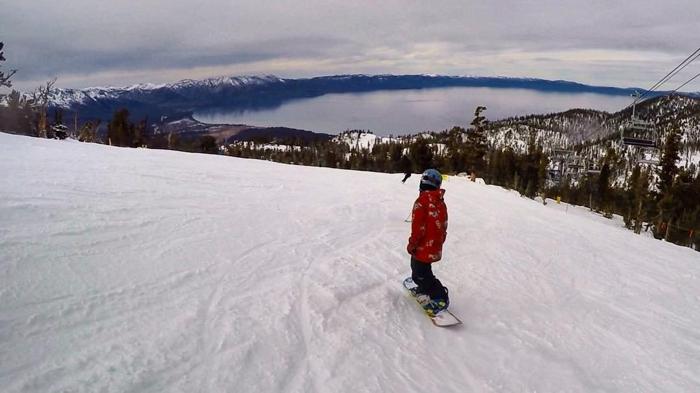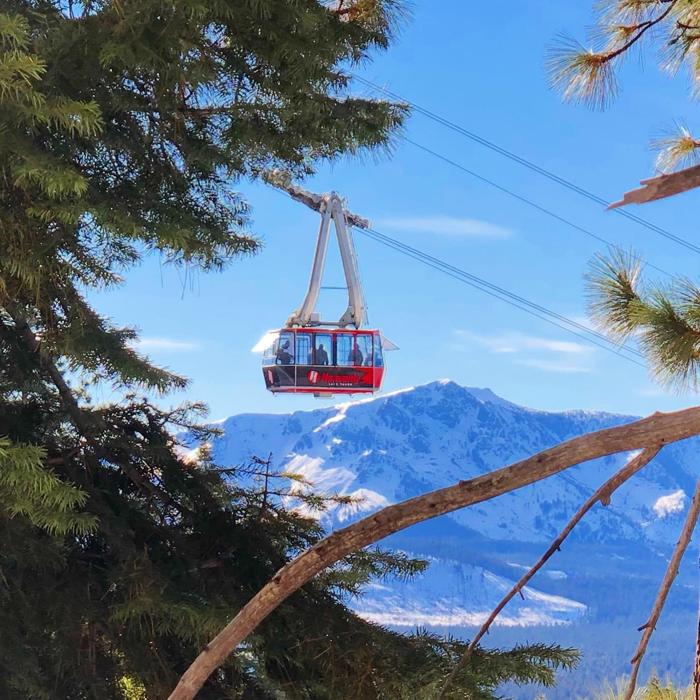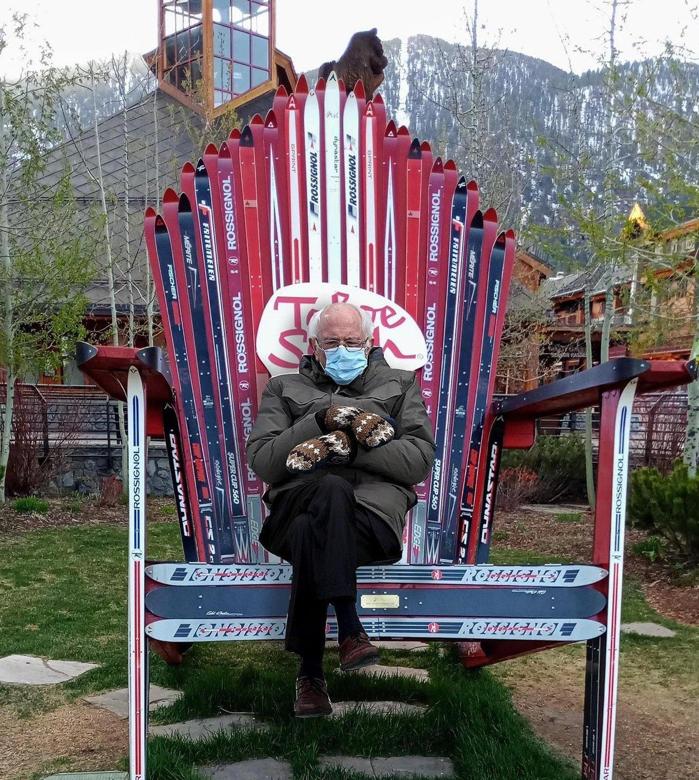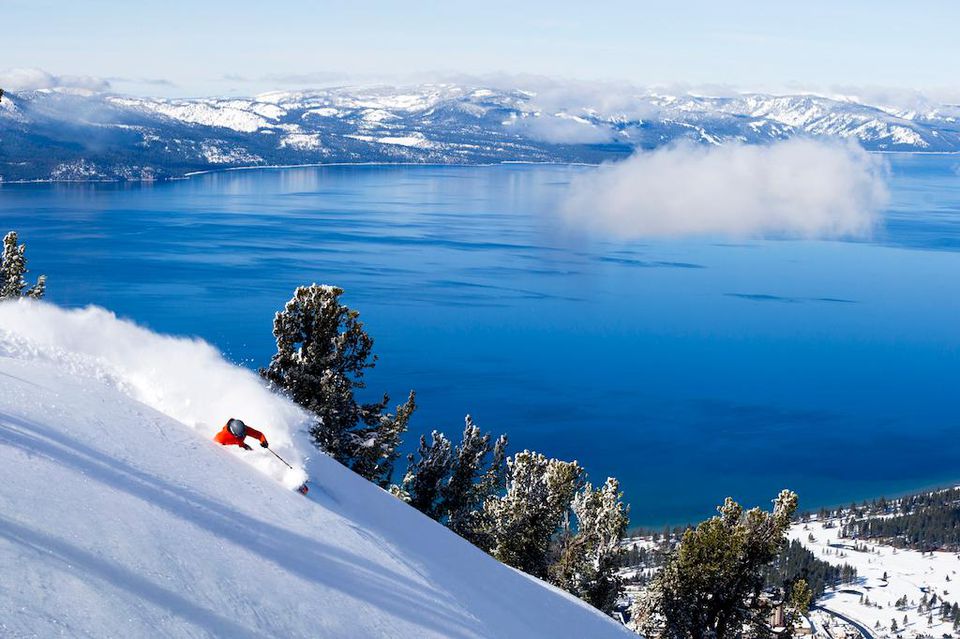Barton Health welcomes first baby of 2026
SOUTH LAKE TAHOE, Calif. – Barton Health welcomed the first baby of the New Year on January 6 at 2:36 p.m. Murphy Vera Ross, female, weighing 7 pounds, 11 ounces, and measuring 20 inches long, was born to Ashley Brier Ross and Barret Ross of South Lake Tahoe, CA. Dr. Megan Jewell, board-certified obstetrician and gynecologist (OB/GYN) led the care team during the delivery at Barton Memorial Hospital’s Family Birthing Center.

Both parents shared how meaningful it was to welcome their daughter at Barton Health, a place that is not just their workplace but also feels like an extension of their family. “Welcoming our daughter at Barton means more than just a place of birth; it means beginning her life surrounded by a team that feels like family. We are deeply grateful for the care and support that made this experience so special.” Ashley is a registered nurse on Barton’s surgical services team, and Barret works as a nurse practitioner in the Barton Community Health Center. They have a 3-year-old daughter, Baldwin, who was also born at Barton Memorial Hospital.
The family was presented with a wagon filled with gift items donated by local businesses and organizations valued more than $2,100. This ongoing tradition unites the community in celebrating the first baby of the New Year.
Barton extends a heartfelt ‘thank you’ to the many local merchants who contributed to the family’s gift: Bert’s Cafe, El Dorado Savings Bank, South Tahoe Now, Tahoe Knight Monsters Hockey, Toy Maniacs, and Thran’s Flowers. Additional donations from Barton Health teams include Barton OB/GYN, Family Birthing Center, Pediatrics, Education, Performance, Plastic Surgery, Public Relations, Human Resources, and the Barton Auxiliary.
Homeless in paradise: unhoused populations in Tahoe and the services that help them (part 2)
LAKE TAHOE, Calif./Nev. – Winter is usually the time when people in the basin think about homelessness—it’s when the risks are highest for those who are unhoused and when operations like warming centers are the most critical. But year-round, organizations like Sierra Community House and the Tahoe Coalition for the Homeless as well as others provide critical services to those in most need.
Part 1 of this feature covered what homelessness looks like in the Tahoe Basin and how homelessness services collect data. Now, we’ll cover what services are available to unhoused people and what changes are on the horizon for them.
What services are available?
The majority of services are available on either the south or north shore. While Douglas County, Washoe County, El Dorado County, Nevada County and Placer County all technically provide services for residents on the east and west shores, they are often off the mountain and require transit by car to be accessible. More often than not, unhoused people trying to remain in the area will seek out services that will let them remain in the basin rather than going down the hill unless it’s absolutely necessary.
South shore
On the south shore, the main services come from the nonprofits Tahoe Coalition for the Homeless, Tahoe Youth and Family Services and Vista Rise Collective, formerly known as Live Violence Free.
Collectively within El Dorado County, a process called Coordinated Entry, through the Homeless Management Information System helps to match people who are experiencing homelessness with the best fit resources within the community.
Tahoe Coalition for the Homeless used to run the warm room, and now runs an emergency shelter with 14 beds, medical respite for Medi-Cal individuals either experiencing homelessness or are at risk of homelessness, rapid rehousing that provides permanent housing on a short or medium-term basis, as well as rapid rehousing for survivors of domestic violence through a program called ARISE. They also provide street outreach which provides navigation services, Coordinated Entry enrollment, hygiene and survival supplies and Narcan distribution. The coalition also provides scheduled use of clean restroom and shower facilities, a community computer, a telehealth and Zoom room, as well as a mailing address and mail services.
Diane Ratcliff recently became the executive director at the coalition and is interested in increasing their volunteer programs and individual donor base, as well as integrating the community more into the work they do. “I would also love to get a learning center at some point in the future so we would be able to get our clients job skills and GEDs,” said Ratcliff.
The Tahoe Youth and Family Services runs the Emergency Winter Shelter from November 1 to April 30, offering immediate access to safe, temporary housing as well as meals, clothing and hygiene resources. They also do street outreach, provide rapid rehousing and case management resources, as well as transitional living programs that help teach youth how to live with roommates and build credit, as their leases are in their names.
Executive director Cheyanne Lane is interested in expanding their transitional living programs and wants to set a long-term goal for a capital campaign, getting a 10-room motel for single-room occupancies, as well as bringing their emergency shelter and transitional housing onto one site. “I dream of sustainable revenue for every nonprofit here.”
Vista Rise Collective focuses primarily on housing domestic violence survivors, who make up a significant portion of unhoused women. Like other services, they pay for deposits and rents, then have a stepwise service that helps foster independence as survivors transition to housing. They have a safehouse in a confidential location specifically for those escaping domestic abuse, where people can stay for up to 90 days. They now have transitional units as well as the ability to provide emergency stays at hotels if needed and case management for employment, financial literacy and budgeting.
Executive director Chelcee Thomas championed the Housing First model, which prioritizes getting people into housing before addressing other issues. “When survivors are facing crisis, they’re faced with tough choices, like deciding whether they’ll pay the rent or feed their families. When we can lessen the impacts of expenses towards housing, it can make their lives that much easier.”
Thomas recognized the difficulties of housing in the Tahoe area, especially because housing is expensive here to begin with, and those who experience domestic abuse in the area may not be safe to live here. “It’s a hard decision and for some of our clients, it may be the right decision to move out of the area. But for others, we want to support their ability to live here in their community even when the housing prices in Tahoe can be very daunting.”
Many of the services here have established relationships with landlords and property management companies in the area in order to collaborate and leverage resources. Vista Rise Collective and Tahoe Coalition for the Homeless both have pay-for-success contracts with the city, which have enabled them to pay for properties and provide services the city wouldn’t normally be able to. “We feel like it helps us to break down these silos between different groups, and leveraging funding from the city bypasses the long wait times for funding from the state.”
North shore
On the north shore, the services provided are primarily through the organizations Sierra Community House, Tahoe Family Solutions and AMI Housing. Major action has also come through the work of the Tahoe Truckee Homeless Action Coalition (TTHAC).
Sierra Community House pulled together several organizations and provides a wide variety of resources across the housing spectrum. Many of their programs are targeted towards homelessness prevention, such as rental and utility assistance, housing advocacy for mobile home users, legal assistance programs and help with navigating affordable housing. They also provide rental assistance for domestic abuse and sexual assault survivors, as well as case management, transitional housing and rapid rehousing.
Executive director Paul Bancroft emphasized the importance of their local partnerships, saying, “It’s so critical here we live, especially with no central seat of the government—it’s what this organization was really born out of.” They sometimes receive clients through their connections with law enforcement and the hospitals, which is a common path for homelessness services to receive clients. The organization also does food distribution, which sometimes helps connect clients there with other needed services.
Sierra Community House has also had a positive reception for its work with connecting with landlords and property managers to help troubleshoot and get resources to better manage their properties and provide a safe place to live.
Tahoe Family Solutions operates in Incline Village and Crystal Bay, but their clients come from around the north shore as well. Like the Sally Fund, a recent flexible housing fund started by the St. Patrick’s Episcopal Church, they offer emergency assistance funds, especially for those struggling with housing. They also offer advocacy, mental health and case management services, food stamps and employment help—all of which are tied to homelessness prevention to executive director Jody Wright.
Wright says that they need more in the Incline Village and Crystal Bay area though. “We need a warming room up here. And we don’t have any treatment programs here—I have to refer people to a program in Truckee because, even if someone wanted to go to Alcoholics Anonymous here in Incline, there’s no anonymity in a community this size.”
Wright also acknowledges that the need is rapidly growing for their services, especially among youth and veteran populations.
AMI Housing, which also does business as the North Tahoe Truckee Homeless Services, has operated the warming center, day center, permanent supportive housing and outreach in north Tahoe and Truckee since 2021. They cover Truckee, Placer County and Kings Beach, offering connection to resources like getting IDs, vouchers, medical appointments and subsidized housing as well as a lunch program at the Truckee Joseph Center. AMI Housing also operates the only permanent supportive housing in the area, Brown Bear Studios in Kings Beach, which supports adults with mental illness to meet their daily needs. The organization wants to focus on better pathways and increased outreach in the community, aiming for permanent and long-term housing, as well as the prevention aspect.
What’s changing in the future?
Changes are on the horizon for many of these organizations, primarily for those that rely on funding from the state and federal levels. And while the COVID-19 pandemic created many funding opportunities and grants that projects were able to rely on, as the five-year mark passes, many of those dollars have dried up. Emergency housing vouchers from COVID-era funding is going away, making it complex for those who urgently need a place to stay.
Continuums of Care (CoCs) receive funding from the Department of Housing and Urban Development. These have historically shifted from year to year, and nonprofit organizations have to seek out projects that match the funding sources that they can find.
But funding now has made a major shift from a Housing First model to one that is focused on interim housing, rather than permanent housing. The recent notice of funding opportunity also makes funding competitive where it has not been before, stops organizations from making decisions under “the pretext of harm reduction,” includes language that would prohibit disabled people, immigrants, LGBTQ+ people and people of color from receiving more specialized treatment and requires “service participation” in order to receive housing services.
These shifts have happened without advance notice to CoCs, which has been given in the past, and mark a heel turn from policies of the past. They also disproportionately harm marginalized groups who are often at more risk of homelessness than other groups.
“This Notice of Funding will have a massive impact on our system,” said Jazmin Breaux, Nevada County Health and Human Services Program Manager. “For the last decade, policy has been very strong about housing first and permanent supportive housing… so it’s hard to shift when you’ve been building around a certain model and hard to plan a program around shifting priorities.”
On the state level, the Homeless Housing, Assistance and Prevention (HHAP) grant allocations are shifting as well. Back in June, the state legislature eliminated new funding for the program and doesn’t even guarantee the $500 million for fiscal year 2026-2027—which is half of the $1 billion that was allocated in 2024-2025.
Here in Tahoe, it would impact programs like the transitional housing for the Tahoe Youth and Family Services. “It’s very precarious, for sure,” said Lane. “And on the federal level, they really don’t like the DEI aspect—they’re cutting things that have to do with Black and Indigenous people of color as well as LGBTQ+ youth.”
It’s one of the reasons El Dorado’s navigation center is shifting focus, so they can secure funding through behavioral health funding rather than HHAP funding. Later this month, the Board of Supervisors is expected to hear an item on it. Timalynn Jaynes, assistant director of health and human services for El Dorado County acknowledged that it was challenging for these programs to figure things out as things shift.
“The state of California and the federal government are not on the same page right now,” Jaynes said. “And you cannot run a project with two opposing requirements.”
“I don’t trust federal dollars right now,” said Wright. “It’s a difficult process to get them and there’s a real climate of uncertainty. We’re blessed and cursed to rely on donations rather than state and federal dollars. But the need doesn’t go away just because the money goes away.”
Community and city funding still remains a strong way for these services to continue. “In a way, these nonprofits actually save the city a lot of money by providing services that they can’t,” said Jessica Wackenhut Lomeli, El Dorado CoC Board co-chair. The city of South Lake Tahoe has pay for success contracts with both the Tahoe Coalition for the Homeless and Vista Rise Collective, which also receive donations to help them run.
But even at the city level, funding could be precarious. Last year, city council chose to cut the cannabis tax, which left nonprofits wondering about their ability to fund critical programs. “Nonprofits like us are the fabric keeping a portion of this community up and running,” said Lane.
In the north shore and Truckee, the pilot navigation center received contributions of $360,000 each from Nevada County, Truckee and Tahoe Forest Health System, with a community donation fundraiser to fill in the gap of $270,000. But the lease will take time and likely won’t be opening on the timeline that the TTHAC originally hoped.
Ultimately, homelessness is a complex issue, and it will take more than just one kind of solution to fix it. “Churches can’t fix it alone, nonprofits can’t fix it alone and counties can’t fix it alone,” said Cathie Foley, a longtime worker and volunteer in homelessness in the north shore and Truckee. “It is a huge gift to have players at the table together because we really have to work together, especially in times like these.”
Note: There is a poll embedded within this post, please visit the site to participate in this post's poll.‘Stand for Good’ vigil honors woman shot by ICE agents in Minneapolis
SOUTH LAKE TAHOE, Calif. – A vigil and small gathering was held at Lakeview Commons to honor Renee Good, the woman fatally shot by an ICE agent in Minneapolis on January 7. “She could have been any one of us,” said one attendee.
Renee Good, identified as Renae Macklin-Good on hospital records obtained by the Associated Press, was a bystander during protests against ICE taking place in Minneapolis. Police reports from the scene indicated that she was blocking the roadway, was approached by an ICE officer and shots were fired.
Department of Homeland Security Secretary Kristi Noem alleged that Good was trying to block officers with her vehicle and had tried to run the officer over before she was shot.
Good’s death has sparked outrage for many throughout the nation, including those who gathered at the vigil at Lake Tahoe.
“The killing of Renee was basically a murder,” said one attendee. “I would be scared if there were unmarked vehicles and masked men approaching my vehicle, screaming profanities at me.”
One person referenced the death of Heather Heyer, who was killed in 2017 during a peaceful protest when a white supremacist deliberately drove his car into a crowd of people. “That would be an actual death by vehicle.”
Many also grieved Good’s death at the vigil, along with others killed by ICE and the culture of escalating violence that their deaths represented to them.
Operation Sierra Storm Weather Conference returns to Lake Tahoe
SOUTH LAKE TAHOE, Calif. – For its 29th edition, Operation Sierra Storm (OSS) is holding their leading National Meteorologist Conference from January 11-14, with goals to promote Lake Tahoe as the leading ski destination, and invites the public to listen to speakers from OpenSnow, a specialized weather forecasting service used by many in Lake Tahoe, on January 13.
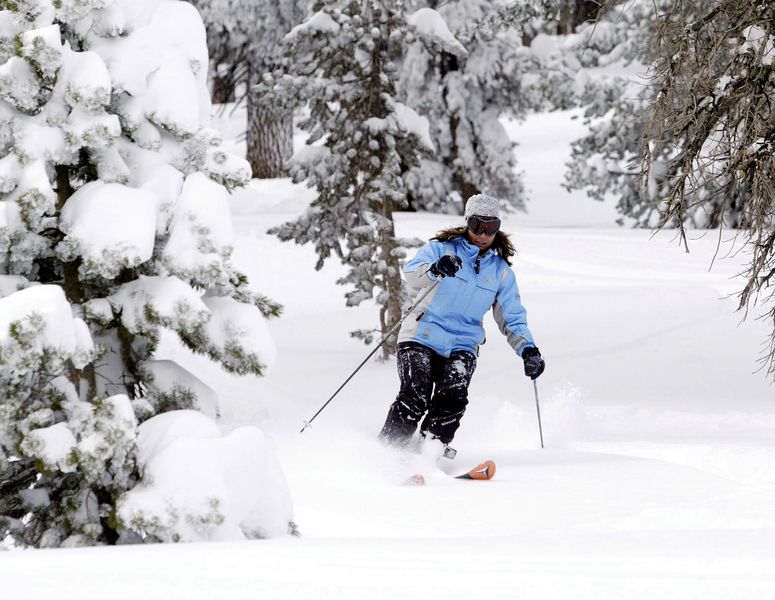
The conference aims to educate network television meteorologists, not only in the region or the country, but around the world, about Tahoe’s winter weather, how to get here safely in the winter, and the products that make us a unique winter destination.
As a Continued Educated Course (CEU) for meteorologists, leading speakers will be in attendance with big names in the industry including Ben Cathey, Mike Farrar, Bryan Allegretto, and Andrew Brady.
Within the last few years, OSS has partnered with the Tahoe Regional Planning Agency (TRPA) and Lake Tahoe Community College (LTCC) to present a public meeting to host one or more of their speakers, allowing the community to engage with OSS’s goals. Whether you’re visiting Tahoe or you’re a local, this year’s Speaker Series: Mountain Weather Forecasting is a great opportunity you don’t want to miss.
“How the Lake Tahoe Region receives its annual precipitation can have a profound impact on the lake’s clarity, the health of its forests, and the safety or our communities,” Tahoe Regional Planning Agency Executive Director Julie Regan said. “Engaging scientists to understand our changing climate is critical not just in our work, but for water quality agencies, emergency managers, and destination management organizations. TRPA is looking forward to working with the college and Operation Sierra Storm to host this important discussion with local forecasting legends.”
The speakers at this year’s public meeting will be OpenSnow forecaster Bryan Allegretto and Andrew Brady, OpenSnow’s Artificial Intelligence Engineer.
Allegretto, one of OpenSnow’s pre-launch partners, is often seen providing many of OpenSnow’s accurate storm and snowfall forecasts, used heavily by Tahoe locals.
Brady, founder of AtmoSphere Analytics, strives to create technology capable of forecasting weather weeks in advance by using machine learning techniques and artificial intelligence.
Together, they bring an opportunity for community members to engage in real-life learning outside of the classroom, with topics such as climate change, meteorology, environmental communication, and data processes.
Carol Chaplin, President and CEO of the Lake Tahoe Visitors Authority (LTVA), said, “The TV meteorologists that attend are from key flight markets into Reno Tahoe Airport as well Northern California. Several come every year while a strong percentage are first time visitors.”
Last year, the four-day, three-night conference brought in 28 leading broadcast meteorologists with featured markets including NBC and CBS National stations from all over the country, as well as the San Francisco Chronicle.
Markets this year will include The Weather Channel, New York, Washington DC, Atlanta, Boston, Miami, Tampa, Orlando, Bay Area, Monterey, Sacramento, Cleveland, Charlotte, Nashville, Lansing, South Dakota, Myrtle Beach and Reno.
“Operation Sierra Storm annually generates major media attention on television broadcasts and social media for the South Shore as a top winter destination – the only one in the country that offers spectacular skiing variety and outdoor recreational options combined with 24-hour indoor attractions and amenities,” said Chaplin. “Not only are they here for ongoing education but they also serve as a trusted resource to their online viewership on where to eat, stay, play while at the conference.”
The free Speaker Series: Mountain Weather Forecasting event will be held at the Lake Tahoe Community College Duke Theatre on January 13 from 4 p.m. to 5 p.m. and is open to the public.
To learn more about the LTCC Speaker Series, check out LTCC’s calendar page.
Operation Sierra Storm’s mission, as well as details on its innovative meteorology conference, can be viewed at osstahoe.com.
Obituary: Judy Moore
February 7, 1943 – November 28, 2025
Judy was defiantly a long time Tahoe lover…She moved here from San Francisco in 1969; with her two boys Damon and Sterling Moore. She worked up until the day she passed at Harvey’s Resort/Casino, now Caesar’s republic for the past 57 years. She started in the Food and Beverage Department and transferred to the Games Department were she worked as a dealer until her last day. Judy loved life until the very end, she was always in great spirts until the passing of the love of her life, the passing of her grandson Zackery Teal Moore when you could tell she just was never the same, again.
Judy’s Funeral Services will be done on Wednesday 14th 2026 @ 1:30pm at St. Theresa’s Church, where she will have a traditional Catholic Funeral Mass.
Actor Jeremy Renner is back on the slopes at Mt. Rose three years after near-fatal accident
RENO, Nev. – Jeremy Renner, Reno resident known for his roles in big hits like “The Avengers” and “Mayor of Kingstown”, has returned to the ski slopes of Mt. Rose three years after he was run over by a snowplow at his Mt. Rose home.

Renner, during the accident, had suffered more than 38 broken bones, 6 broken ribs, a punctured lung and a split-open skull as he was trying to prevent his Pistonbully snowplow from sliding when he forgot to engage the emergency brake before exiting.
He was transported by CareFlight helicopter to Renown Regional Medical Center in Reno.
This month, Renner took to Instagram, saying while on the mountain in ski gear, “First time back really skiing on this mountain, Mt. Rose, and I ran into the CareFlight pilot that took me to the hospital three years ago,” calling the happenstance “interesting,” and “kind of cool, meeting all these heroes of mine.”
Since his accident on January 1, 2023, Renner told The Times, “I’ll forever be in recovery; it never ends. But I accept that. Given that I was past 50 at the time of the incident I already needed to pay a lot of attention to my body, my flexibility and my joints, so it’s a blessing to now do it in a deeply responsible way.”
Just shy of a year after the accident, Renner was seen returning to Renown Regional Medical Center to give gratitude to the staff who helped save his life, and in his Instagram video, he notes how grateful he is to be able to be back on skis.
His book, “My Next Breath”, was written about his experience, and with his voice, he’s also extended a hand to the community in Reno where he founded RennerVation Foundation, a nonprofit providing support to children in foster care and at-risk youth. The foundation has also funded a camp in Lake Tahoe called Camp RennerVation.
“Every year, foster and at-risk youth will have the opportunity to participate in a week of exciting, educational, and engaging activities,” RennerVation Foundation said about the camp on their website.
Renner appears to be making peace with the seven ton snowplow that nearly took his life, sharing a photo on his Instagram story of the machine. “Not today,” Renner captioned the photo.

Obituary: Gregory Lynn Parker
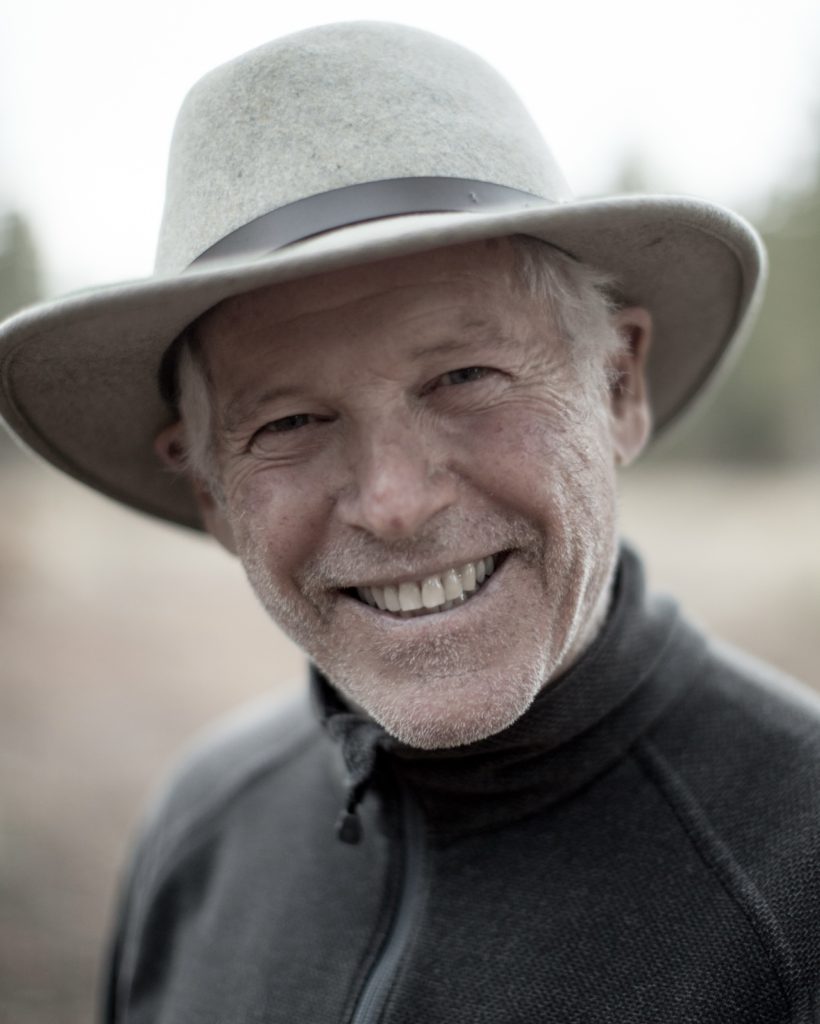
Gregory Lynn Parker
March 24, 1950 – October 22nd, 2025
Gregory Lynn Parker, devoted husband and best dad in the world, left us gracefully on the evening of October 22nd, 2025, surrounded by his loving family and an abundance of love. Born on March 24, 1950, to Jack and Chiara Parker, in Oakland, CA, later moving to Los Altos at 6 months old. Greg was a man filled with kindness and compassion. He was hardworking, good-humored, and rich in life, always carrying a touch of mischievousness in his smile. An athlete and a coach at heart, tennis was his game.
Greg attended Foothill College before continuing on to Stanford University, where he excelled in business, linguistics and demonstrated a natural gift for academics. He graduated in 1972 and played tennis for both Foothill and Stanford respectively.
After traveling the world competing in tennis events, including the Australian Open, Greg met his wife to be, LouAnnein ’73 and a few years later they found themselves on the beach at South Seas Plantation on Captiva Island, Florida, in ’76. Shortly thereafter, Greg became the Head Tennis Professional at the resort. On August 18th, 1978 while visiting Lake Tahoe, he married LouAnne on a beautiful sail boat on the lake. Over the next several years, he grew the tennis program in Florida to international recognition while starting a family with LouAnne.
In 1986, they moved to Olympic Valley, LouAnne’s favorite place on earth. Greg continued to play tennis, coach, raise his family, and later became a realtor. If you were his client, you were lucky—he always went above and beyond. If your kids were the same age as his, you were lucky too, as he likely coached them in soccer, baseball, basketball, or tennis. An ever-present father with a deep passion for athletics and fun, Greg also loved golf, and the Tahoe City Golf Course was one of his favorite places to keep company and work on his game. Upon retirement from real-estate, he became the marshal at TCGC, apparently quite the social marshal who didn’t necessarily speed up play, but certainly shared many smiles alongside his trademark greeting of “Top of the morning to ya!”
Greg befriended everyone, never passed a hitchhiker, and was an extremely proud father. He was full of positivity and loved to make others laugh, especially kids. He would do just about anything for a smile and will be forever missed, but never forgotten.
Greg is survived by his wife, LouAnne Parker; his children, John and Michelle Parker; his brother, John Parker; his sisters, Haydon and Susie; and many cherished nieces, nephews, and friends. He was preceded in death by his parents, his beloved son, Michael, and his sister Lindsay.
A celebration of Greg’s life will be held on January 10, 2026, at 1:00 p.m. at the Olympic Village Events Center (1901 Chamonix Place, Olympic Valley, CA).
His legacy of unwavering support, unconditional love, and altruistic loyalty—always with a sparkle in his eye—will forever live on in the hearts of all who knew him.
School consolidation still on the table for Douglas County School District
DOUGLAS COUNTY, Nev. – The Douglas County school district (DCSD) called a special meeting and primarily discussed school consolidation and staff reductions in an effort to reduce millions of dollars by June 2027. The board anticipates coming to a decision before February break, and will call another special meeting.
During the consolidation presentation, Superintendent Frankie Alvarado said, “It hurt my heart a little bit knowing that potentially, we could be losing schools in our school district.” However, the board is close to a $5.2 million deficit and needs to reduce nearly $6 million by June 2027 in order to get to net zero.
The board will also be reducing over 60 total positions going into the next school year, and approved an item to reduce classified employees and management. They also discussed looking at reductions on the health plan and already made some cuts for custodial positions.
The current consolidation scenarios would be:
- Jacks Valley Elementary and Pinion Hills Elementary
- Scarselli Elementary and C.C. Meneley Elementary
- Zephyr Cove Elementary, George Whittell Middle and High School
If all the schools were consolidated, it would result in estimated savings of $2,277,877, but it’s unlikely they will decide to do all three scenarios. Board members clarified that no decisions have been made yet.
People expressed concerns about the calculations, as well as the reality of consolidations, saying they would likely cause many parents to move their children out of the school districts, lowering enrollment and funding. Some spoke about the importance and value of smaller schools for their children, while others said that the schools were already struggling to meet the needs of special needs children.
Several parents from up at the lake urged the district to hire a CFO and to make a statement that consolidating the lake schools would be off the table. They said it was an unwise financial decision, as they bring in more revenue than other schools and have already experienced consolidation. Consolidating Zephyr and Whittell also presents the complication of having to make accommodations at the high school for elementary aged children and creating a vacant building at the elementary school.
“Consolidating these schools won’t really gain much for the district and may in fact cost more in retrofitting for it to be a K-12 school and the potential loss of students, my family being one of them. We would seriously consider taking them out of the district and sending them to South Tahoe High School where they can get the best education possible,” said Shannon Friedman, a longtime resident in Stateline who said her children have thrived at the lakeside schools. “If they’re consolidated again and we have one K-12 school, enrollment would decline so much, it is one step closer to having no schools at the lake. And what kind of community is that, where you don’t have a local school?”
Assemblyman Blayne Osborn also spoke and said he had relayed concerns to the governor’s office. He expressed that he would like to work to bring state solutions and bills to look at in the next legislative session to avoid issues in the future.
The board requested investigation into two other consolidation scenarios and anticipated calling another special meeting. Their next regular board meeting takes place on January 15.
Mt. Rose Ski Tahoe to host free kids Learn to Snowboard Day
INCLINE VILLAGE, Nev. — Mt. Rose Ski Tahoe will offer a free Learn to Snowboard Day for children ages 4 to 7 on Sunday, Jan. 11, in an effort to inspire the next generation of snowsports enthusiasts.
From 9:30 a.m. to noon near the resort’s Main Lodge, children can try out the mountain’s custom Learn to Snowboard specialty park and begin learning basic snowboarding skills. The free session will feature multiple activity stations designed to introduce young riders to the sport in a fun, low-pressure environment. No equipment is required.
“Learn to Snowboard Day is an opportunity for us to welcome kids into the sport of snowboarding and hopefully spark their interest in making it a lifelong passion,” said Mike Pierce, marketing director for Mt. Rose Ski Tahoe. “While this won’t be a full snowboard lesson, our goal is to introduce kids to the basics and show them how much fun recreating in the snow can be.”
Parents are encouraged to dress children in snow pants and jackets, waterproof footwear and to bring a helmet.
Overnight snow, freezing temperatures lead to icy roads
LAKE TAHOE, Calif./Nev. – Despite clear skies, chain controls are still in effect for major roads in and out of the Tahoe Basin due to icy conditions.
Chain controls are in effect on I-80 from Nevada State Line to Baxter. Chain controls are also in effect on Highway 50 from Kyburz to Meyers.
Due to icy conditions on SR 431, Washoe County School District delayed the Incline Village school start by two-hours.
While the high is around 27 degrees on Thursday, temperatures are expected to rise over the weekend, with highs in the high 30s and 40s.
Knight Monsters Forward Sloan Stanick named to 2026 ECHL All-Star Team
STATELINE, Nev. – The Tahoe Knight Monsters announced today that forward Sloan Stanick has been named to the 2026 Warrior/ECHL All-Star Classic, presented by Visit Allen, Texas and Allen CDC.
Stanick currently leads the Knight Monsters with 34 points in 29 games this season. Stanick is also tied for the team lead in goals with 15 and tied for the team lead in assists with 19.
Stanick is currently recalled to the Henderson Silver Knights of the American Hockey League. In 99 career games with the Knight Monsters, Stanick has recorded 113 points.
The 2026 Warrior/ECHL All-Star Classic, presented by Visit Allen, Texas, and Allen CDC, will include the induction of the 18th class into the ECHL Hall of Fame on Monday, January 19, 2026, at the Courtyard by Marriott Dallas/Allen at the Event Center, the official host hotel of the 2026 Warrior/ECHL All-Star Classic.
The Knight Monsters return home on Friday, January 9, 2026, to take on the Utah Grizzlies for the first night of Military Appreciation Weekend at Tahoe Blue Event Center. Puck drop is at 7:00 pm, with pregame coverage on the Knight Monsters broadcast network beginning at 6:50 pm. Ticket packages for the 2025-26 season are now available. For more information, visit www.knightmonstershockey.com
An Epic Promise; How Heavenly gives back to the community, environment
For many visitors to Heavenly Mountain Resort, they only experience the fun aspect of the mountain, whether that’s the intense powder days in the winter or a beautiful gondola ride in the summer. And while Heavenly does strive to continue to bring fun and adventure to visitors, it also adheres to higher standards. The resort has worked tirelessly to meet and exceed the commitments they’ve made to the community it operates in and the environment as a whole. This is the goal of the Vail Resorts EpicPromise.
Supporting resort communities, increasing access to snowsports, and being responsible environmental stewards is ingrained in the history of Vail Resorts. EpicPromise brings this work to life and is one of the ways the company supports one of their core values, “Do Good.”
“The launch of EpicPromise is just the first step as we look forward to implementing new programs and efforts in the coming months that build on our sustainability leadership,” said a 2017 press release announcing the launch of the program. “From our commitment to sustainable operations to inspiring our guests to make their own impact, we want to be a company known for taking action.”
As part of Vail Resorts, Heavenly also has a long history of environmental and community stewardship and mountain staff have fully embraced EpicPromise as a way of life at Heavenly.
Heavenly’s EpicPromise
Heavenly and Vail Resorts’ EpicPromise is their commitment to being responsible stewards of the environment, to ignite a passion for the outdoors for the next generation of skiers and riders, and to support our team members and local communities for a bright, sustainable future.
Ryan Smith, Regional Senior Manager of Building Maintenance at Heavenly and Kirkwood, is the EpicPromise Champion at Heavenly. Smith, who also serves on the Tahoe Chamber Board of Directors, sees the value in not only personally being involved in the community, but for Heavenly as a whole, to give back.
“We really want to make sure we’re proper members of our community and we’re giving back, especially in the areas that support our priorities,” said Smith. “And really that we’re supporting those agencies that make our communities better.”
Community Giving
Heavenly and Kirkwood support 46 organizations locally, including the The League to Save Lake Tahoe, Bread & Broth and the Tahoe Fund.
In 2025, the resorts donated $2.5 million back into the community, which has increased year-over-year. Organizations apply for grants each year, and a committee determines if they match Heavenly’s values.
Youth access is one of the values that’s very important to Heavenly. The mountain has partnered with Lake Tahoe Unified School District to ensure all fourth and fifth graders in the district have access to rentals, lessons and to the mountain. They’ve provided the same support to the Washoe Tribe.
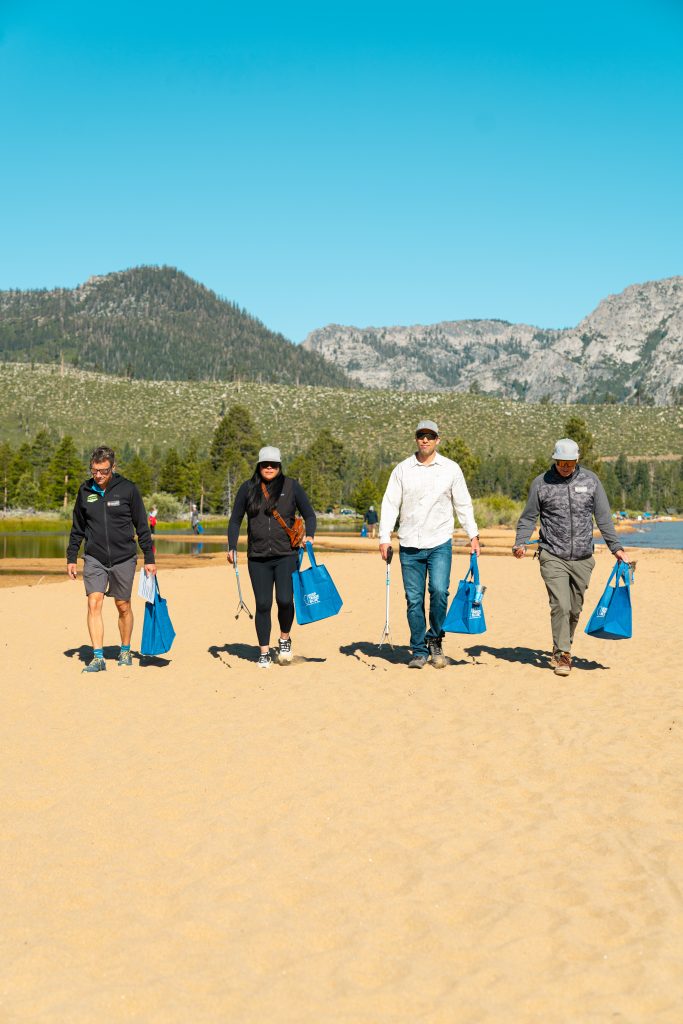
“For us, it helps us to get more people introduced to the sport we all love,” said Smith. “That’s one of our key priorities, helping people get up on the mountain.”
Smith added that in 2025, Heavenly and Kirkwood supported over 2,200 youth.
Heavenly has also made a multi-year giving commitment to the Boys & Girls Club of Lake Tahoe.
“The Boys & Girls Club is really near and dear to our heart because we recognize that not only does it support South Lake Tahoe as a whole but definitely our employees,” said Smith, adding that employees at Heavenly and Kirkwood use BGCLT.
The resort not only provides financial support but also boots on the ground support. Each winter, Heavenly hosts Ski with a Ranger events in partnership with USDA Forest Service Lake Tahoe Basin Management Unit. The free event helps educate the public about the mission and role of the Forest Service in ski area management, improve public understanding of natural resource processes and issues, and promote environmental literacy and stewardship.
Employees are also encouraged to give back to the community. Employees have volunteered with the Sugar Pine Foundation to plant thousands of saplings, they’ve worked with the Tahoe Rim Trail Association to help build and maintain trails, they’ve worked with the League to clean-up beaches and they’ve served hundreds of meals with Bread & Broth.
Employee Support
Additionally, Heavenly provides direct financial aid to their employees through the Vail Resorts EpicPromise Foundation.
According to the Vail Resorts website, “The Vail Resorts EpicPromise Foundation is a public charity designed to provide our team with pathways to stability and access. The foundation is funded by an annual $500,000 contribution from Vail Resorts, as well as generous donations made by Vail Resorts team members and guests.”
The foundation provides Hardship Relief Grants, Educational Ascent Grants and EpicPromise Scholars Grants.
Employees can apply for Educational Ascent Grants for a one-time scholarship used to pursue a degree or certification. EpicPromise Scholars Grants are aimed towards dependents of Vail employees for tuition expenses.
The Employee Hardship grants provide short-term aid following a critical, unexpected event addressing emergency expenses. They can be applied for by an employee, or an employee can fill out a referral for a coworker.
Smith said the foundation was able to step up in a big way during the Caldor Fire.
“During the Caldor Fire, it was able to provide financial assistance to all our employees who were forced to relocate and evacuate,” said Smith.
In addition to natural disaster relief, employees can apply for grants to support medical emergencies, rehab programs, domestic violence support or home repairs when homes are made uninhabitable.
Commitment to Zero
Supporting the environment is a main focus for Heavenly, and while they’ve provided thousands of dollars in grants to environmental organizations, they’ve also looked inward at ways they can change how they do business to be more sustainable.
In 2017, Vail Resorts made a Commitment to Zero pledge, a bold goal to reach zero net emissions, zero waste to landfill, and zero net operating impact on forests and habitats by 2030. And according to Lila Peterson, Sustainability Manager for West Regional Destinations + Australia, Heavenly is on track to reach that goal.
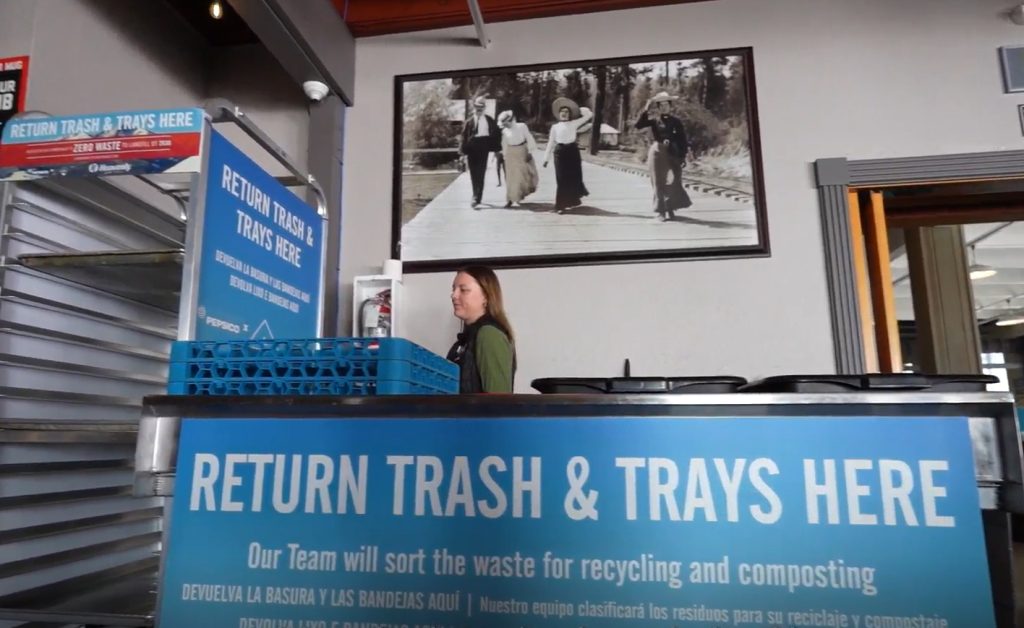
Net zero is a big goal to reach and 2030 is not far away. So, how does a mountain like Heavenly begin tackling that big of a project?
“Our main strategy is making partnerships, working holistically, looking for different opportunities to invest capital and trying to be as innovative as we can,” said Peterson.
For example, Heavenly has partnered with Liberty Utilities to replace snow making equipment in favor of higher efficiency. Heavenly is also piloting electric vehicles, replacing lights with LED, and upgrading heating equipment. They’ve also engaged employees in behavior change campaigns including daily energy checklists, end-of-season shutdown procedures, and IdleWise – an initiative to reduce vehicle idling.
Another area Heavenly has made a lot of progress is with waste to landfill reduction, which might not be the sexiest topic but it’s one Peterson cares deeply about.
Heavenly has focused on waste diversion through recycling and composting and reducing the amount of waste overall. That includes moving toward reusable and durable dish wear at mountain restaurants and staffing employees who are trained on diversion. Those employees sort trash behind the scenes to make sure all waste is going to the correct place.
“It takes waste out of the guests’ hands so that they can focus on having fun at the resort versus trying to figure out all of the different ways that we’re diverting waste from landfill,” said Peterson. “That’s something that makes Heavenly and all of our resorts that do this kind of waste sorting super unique because it’s not something that’s very common in the food and beverage industry, especially in quick-service locations.”
It’s not just in food and beverage locations that Heavenly is making changes. They’ve partnered with Trex, a company that specializes in recycling soft plastics, which are the materials used in shipping clothing and retail items. The company uses that material for decking and furniture. Since program adoption, participating resorts have recycled 30,000 lbs of this material across the Vail Resorts enterprise.
“We’re super excited to collect and recycle this material because it is so commonly littered,” said Peterson.
The resort has also started to move away from plastic lift passes. Guests can now use a digital mobile pass through the My Epic app. This is an opt-in program so guests with season passes from the past season can still use those hard copy passes.
“We partnered with the pass media supplier to create a program where we can collect end of life pass cards from guests and employees for recycling,” said Peterson. “We’re keeping things like those passes out of the landfill which may seem small, but it really adds up over time.”
So the next time you’re visiting Heavenly, think about the ways your dollars are being turned out and used to support South Lake Tahoe and the environment as a whole.
“Our resorts have a large influence on our surrounding communities, and it’s our responsibility to be leaders in sustainability and active stewards of the natural environment in Lake Tahoe and beyond,” said Peterson.
To learn more, visit https://www.skiheavenly.com/the-mountain/more-options/epicpromise.
Tahoe’s Best Mulled Wine
There’s nothing like sitting slopeside of a mountain on a wintry day, gazing across the lake from the upper deck of a wine bar, or hanging out with your friends after the day ends to reminisce about your recent adventure with a hot cup of mulled wine in your hands.
Thought to have originated in ancient Rome to provide warmth, flavor, and medicinal properties during the chilly months, hot mulled wine has a long history of adding a bit of flair to European ski towns. And while everyone from Martha Stewart to the New York Times has their own recipe on how to make it, here’s where you can find it in Tahoe (along with local bartender commentary about what makes theirs stand out):
The Chalet at Palisades Alpine, Tahoe City
The small ski-in ski-out Bavarian style ski lodge is best known for its partnerships with local proprietors to create its giant pretzels and sausages, but the first thing I noticed while taking a snowboarding break last season was how delicious their hot mulled wine is. While Alpine Food & Beverage Director Dan Sanderman and F&B General Manager Sullivan Ware wouldn’t share the exact recipe for its mulled wine, they did admit that it’s made with mulling spices, brandy, and a half portion of red wine, then the spices are steeped for 6-8 minutes (Sanderman admitted that the process involves steeping the herbs in a bouquet garni wrapped-cheesecloth technique). Once cooled, they add the other half of the wine along with some brandy.
The mulled wine is served at its special Chalet Dinner series events, as everyone is given a cup at the Alpine Lodge before snowshoeing up under the stars to the cozy Chalet.
“I’ve been here 11 years, and it’s been a consistent bar drink for a decade,” Sanderman adds.
Snowflake Lodge at Diamond Peak Ski Resort, Incline Village
Served at Diamond Peak’s mid-mountain Snowflake Lodge and/or the Loft Bar at its Main Lodge, this ski resort’s take on the classic winter wine drink involves a cozy blend of grenache and merlot gently simmered with French brandy, golden honey, star anise, cinnamon sticks, orange zest, cranberries, and cloves.
“The result is a rich, aromatic winter favorite that’s sweet, spiced and perfectly balanced to chase away the chill during or after a day on the slopes,” says Diamond Peak Marketing Manager Paul Raymore.
Café Zenon at the Tahoe City Winter Sports Park, Tahoe City
When the winter months come around, Tahoe City Golf Course turns into a winter wonderland with cross-country ski trails, an ice skating rink, sledding, and snowshoeing activities.
Next to the ice skating rink, Café Zenon serves grab n’ go snacks and warm fare including favorites such as grilled cheese sandwiches, chicken tenders with fries, and a Vietnamese French Dip. But its cocktails are just as well known as its food, with its winter mulled wine especially being a big hit.
“We make this every winter. I use a traditional Scandinavian wine recipe, with a popular Swedish Glogg wine but have done some iterations off that,” says Café Zenon General Manager Jake Spero. Spero ran the bar at PlumpJack Café for many years testing out different mulled wine recipes before bartending at Café Zenon, where he’s continued to perfect his mulled wine recipe for the last seven winters.
“I’ve made many batches of mulled wine,” he says. “I’ve done a lot of research on how different countries do it; I’ve looked up German versions, how they make it in France, and in other countries. Every country has their own recipe. It’s a fun rabbit hole to go down, experimenting with different mulled wines.”
His favorite mulled wine recipe includes a little agave with fennel, in a combination close to a Scandinavian style of gin. Café Zenon unrolls all its winter hot drinks out around Thanksgiving, which also includes a hot butter rum, snugglers, hot toddies, and a hot apple pie made with Tuaca and cider from Apple Hill—all equally as popular as the hot mulled wine.
“It’s the same apple juice [from Apple Hill] that the kids drink, we just add some Tuaca to the adult version. And then everyone just sits by the fire and gets all warmed up,” Spero smiles.
Himmel Haus, South Lake Tahoe
Across the street from Heavenly’s California Base Lodge is “Tahoe’s wurst experience”, the Himmel Haus. The German Bavarian acts as a popular go-to for skiers and riders coming off the mountain, filtering in to warm up next to one of its stone fireplaces and grab a schnitzel.
During its Oktoberfest celebration as the servers all walked around dressed in dirndls, the bartender who’s been there for seven years named Charlie said that they bring out their mulled wine around Thanksgiving—or when it really starts getting cold. It consists of a red wine and blend of herbs (such as star anise, cloves, juniper, and cinnamon sticks) combined with cinnamon, whiskey, and honey, using a percolator to steep it.
“Once the mountain opens it gets busy; we sell a lot of mulled wine to skiers coming in,” he says. “It creates a nice aroma throughout the restaurant.”
The Idle Hour, South Lake Tahoe
Located on Lake Tahoe Boulevard, The Idle Hour is the best place to go to enjoy a glass of wine no matter what kind of varietal you’re into… mainly because its cozy two-story interiors project directly over Lake Tahoe. The first time I went to The Idle Hour was in February 2021. It was in the heart of the winter season and the moment I walked in I was greeted with a steaming cup of mulled wine, the pot of it kept hot on a soup warmer. The GM at the time told me that “people can’t get enough of it.” I had brought a book with me but ended up looking at the lake instead.
Now, four years later, not much has changed. The Idle Hour still has that same welcoming atmosphere with unparalleled views and serves up its signature hot mulled wine all winter long starting in October.
“We have some proprietary spices and mix it with apple cider and merlot,” says The Idle Hour General Manager Alex Reber. The Idle Hour sees a spike in mulled wine sales in November/December, but they also give discounts on it on National Mulled Wine Day, which is March 3, 2026.
Cold Water Brewery, South Lake Tahoe
The inside of Cold Water Brewery is clean and cozy, with the bar easily to spot when you walk in. The bartender Jordan (who’s originally from South Lake Tahoe and moved back after spending a stint in Florida) always seems to stay busy, expertly mixing up drinks and pouring its signature beers out of the tap for thirsty patrons.
Since at the time of this writing it was still Oktoberfest season, Cold Water Brewery hadn’t brought out their adult winter concoctions such as its Hot Buttered Rum or Remedy (turmeric, ginger, honey, black pepper, whisky) yet. While they don’t technically have a mulled wine on this season’s menu, Cold Water does serve a winter sangria which comes darn close. Cold Water Brewery keeps a mulled spice wine concentrate on hand year-round, adding hot water to it in the colder months and a splash of Sprite or soda water to it in the summer over ice.
The winter version is made with red wine, triple sec, brandy, OJ, pineapple juice, and a batch of winter spices such as cloves, allspice, thyme, star anise, and cinnamon that simmer in a crockpot for a few days, then is strained out. As with a typical sangria, the fruit added to it soaks up much of the alcohol which serves as an adornment to the drink.
I tried the iced version and tasted winter flavors, especially the allspice and thyme. Taking a bite into the boozy peach perched on the rim, it tasted of triple sec. Yep, one of these when it’s snowing outside will warm you right up.
Editor’s note: This article originally appeared in the Winter 2025/26 edition of Tahoe Magazine.
EAT This Week: Get Rad Pizza’s Pow Day
To try and decide each week where and what to eat around the basin can be a challenge – there are so many amazing choices. In this feature we’ll dive into dishes that will surely satisfy those hunger pangs and leave you wondering where to go next.
I feel like with winter finally doing winter things and seeing all the fresh snow drop over the past couple weeks, it was only fitting to have this week’s feature. I mean, the name alone says it all. But the taste says even more.
Built into Get Rad’s food truck is a wood-fired oven, which for pizza, is a perfect pairing. Not only does it bring amazing texture with charred pockets of crust but that super high heat from the wood adds a slight smokiness to the flavor. You can pretty much pick any combination and it’s going to rock, but one of their best sellers just might have the edge.

For this pie, and really most of their offerings, the dough gets a slathering of organic Bianco DiNapoli tomato sauce. The sauce is made with simple and clean ingredients, which when it comes to Italian food, you know helps yield superior flavor. It’s finished off with a hearty dosing of mozzarella, pepperoni, ricotta, and spicy honey.
Now, one might think the addition of spicy honey is the thing that sends this over the top – and it definitely helps with adding in a sweet-heat juxtaposition – but for me, it’s the addition of the ricotta. That little bit of tanginess along with the creamy texture, is the thing that really butters my biscuit.
Don’t get me wrong – the crust, pepperoni and mozzarella are all fantastic partners in crime, but there’s something about the ricotta (and spicy honey) that puts this pie into its own unique orbit. If you’re looking for something familiar, but want to branch out, you won’t be disappointed.
Get Rad Pizza is a food truck, primarily serving the south shore of Lake Tahoe, and typically found parked outside The Hangar. For menu items, locations and general information, visit them online at getradpizza.com or search for them on social media.
Action in Tahoe: Tahoe Adventure Film Fest, Urban WinterFest 2026, Winter Wildlife Nordic Ski and more!
Friday, January 9
DJ DELO in the Mix – 9-11:30 p.m., AleWorX Stateline. For more information, visit https://laketahoealeworx.com/event/dj-delo-in-the-mix/2026-01-09/.
DJ N-Tune at HQ – 9 p.m.-1 a.m., MontBleu Resort, 55 Highway 50. Catch a vibe with DJ N-Tune here at HQ Center Bar on January 9th! For more information, visit https://casinos.ballys.com/lake-tahoe/events-calendar.aspx?date=1/9/202 6&display=event&eventid=2477883 or call (775) 588-3515.
Dueling Pianos at Caesars Republic Lake Tahoe – 8:30-10:30 p.m., Harveys Lake Tahoe, 18 Highway 50. Join us at the Mountain Bar located on Caesars Republic casino floor for a free show you don’t want to miss. Put your favorite song request in, grab a drink at the Mountain Bar and enjoy the fun! Playing Friday and Saturday at 8:30 PM. Dueling Pianos. For more information, visit https://visitlaketahoe.com/event/dueling-pianos-at-caesars-republic-lake-tahoe/2026-01-09/ or call (775) 588-6611.
Tahoe Knight Monsters v Utah Grizzlies – 7 p.m., Tahoe Blue Event Center, 75 U.S. 50. Ages 2 and up require a ticket for entry
Wine Tasting on the M.S. Dixie II – 5-8 p.m., M.S. Dixie II at Zephyr Cove Resort, 760 U.S. Hwy 50. Sip & Sail: A Wine Country Journey on Lake Tahoe. Join us aboard the M.S. Dixie II for an unforgettable evening that pairs the rich flavors of California’s wine country with the perfect appetizer. A curated selection of premium wines by Joyce Wine Co. As we cruise Lake Tahoe, you’ll discover the story of water flowing from the Sierra Nevada to the Central Valley—home to world-class vineyards producing varietals like Cabernet Sauvignon, Chardonnay, and Pinot Gris. For more information, visit https://visitlaketahoe.com/event/wine-tasting-on-the-m-s-dixie-ii/2026-01-09/.
2026 Mid Winter Bald Eagle Count – 9 a.m.-12 p.m., In 2012, TINS took over coordination of the annual Mid-Winter Bald Eagle Survey for the Tahoe basin. From 9am-12pm, volunteers are paired up and stationed at 26 vantage points throughout the Tahoe basin, mostly around the lakeshore. This year’s count is scheduled for Friday, January 9th, 2026. Click Here to Register! When registering, we ask that you provide the following information: Preferred location Are you a first time participant or a repeat participant? Experience level (beginner, intermediate, expert) – we will do our best to pair folks with less experience with experts Phone number / email If you prefer to be paired up with a particular person, please provide their name The count is part of the National Midwinter Bald Eagle Survey that was initiated by the National Wildlife Federation in 1979. Over the years, the coordination of the national effort has changed hands a few times, and is currently managed by the United States Army Corps of Engineers. Most recently the survey at Lake Tahoe was coordinated by the USFS Lake Tahoe Basin Management Unit. Click here to learn For more information, visit https://www.tinsweb.org/upcoming-events/2022-mid-winter-bald-eagle-count-hmzhr-znmje-3ezmx-hbc52.
Winter Pressed Flower Acrylic Hanger Workshop – Symme Trees – 6-8 p.m., Description Join Dana of Symme Trees and celebrate winter with an evening of creativity, cozy vibes, and hands-on making. In this workshop, you’ll create a botanical wall hanger using a thoughtfully curated selection of seasonal dried botanicals. You’ll choose your hanger shape at checkout, with the opportunity to add a second hanger if you’d like to make more than one piece. All selections are made in advance so we can have everything ready for you when you arrive. The workshop space is yours for two hours, with plenty of flexibility to work at your own pace. We’ll provide everything you need, and you’re welcome to bring your own winter clippings or flat keepsakes to make your piece feel extra personal. Sip wine, enjoy light snacks, and settle in for a relaxed, creative evening. You’ll leave with a one-of-a-kind winter accent, or two, to take home. Details: Price: $55 /$95 per person Ages: 14+ Shapes: Circle, Bear, Shape of Tahoe, Tahoe Tessie, or Tree (choose in advance) Includes: All materials, dried botanicals, wine, and snacks (bring your own dried botanicals and small, flat tokens optional!) No experience necessary – just bring your creative spirit! For more information, visit https://business.ivcba.org/event-calendar/Details/winter-pressed-flower-acrylic-hanger-workshop-symme-trees-1560466?sourceTypeId=Hub.
Saturday, January 10
DJ Montague – 9-11:30 p.m., AleWorX Stateline. Additional dates: 1/10, 1/15. For more information, visit https://laketahoealeworx.com/event/dj-montague-5/2026-01-10/.
Tahoe Adventure Film Festival – 7 p.m., MontBleu Resort, 55 Highway 50. The Tahoe Adventure Film Festival (TAFF) is like no other film festival in the world. This is not your typical stuffy film festival. This fun high-energy evening will fuel your passion for action, and ignite your senses for adventure. We highlight the best adventure sports films of the year and showcase the action sports world best talent. All of our films are specially selected and edited to fit our festival’s fast pace format. Our festival is exciting and entertaining on and off the screen. The night includes special guest speakers, action photo displays, break-dancers, and always a few special surprises. The TAFF organizers spend hours pouring over footage, narrowing down the film submissions to the top 10 from every corner of the Action Sports World. From there each filmmaker produces a special 10-12 minute clip or segment to be premiered at the festival. or call (775) 588-3515.
Tahoe Club Crawl Fall/Winter 25/26 – 8-11 p.m., Tahoe Club Crawl, 31 US HWY 50. Tahoe Club Crawl is an organized VIP nightlife tour of the Tahoe South. With the purchase of your ticket, you will receive a welcome shot at 3 out of 4 stops, appetizers, free indoor games at Tipsy Putt and VIP entrance into Peek Nightclub, Lake Tahoe’s hottest Club! You will meet amazing people and have the night of your lives. We meet every Saturday at 8:00 PM Aleworx Stateline, unless told otherwise. Be Sure To Check Out our Ice Cream Shop, Aloha Ice Cream Tahoe “Winner of Best Ice Cream in Tahoe 7 Years In A Row” (Opened Seasonally) For more information, visit https://tahoeclubcrawl.ticketsauce.com/e/tahoe-club-crawl-fall-winter-25-45?aff=cityspark.
Tahoe Knight Monsters v Utah Grizzlies – Military Appreciation Weekend – 7 p.m., Tahoe Blue Event Center, 75 U.S. 50. Ages 2 and up require a ticket for entry
German Biergarten – 9 a.m.-3 p.m., Mt Rose Ski Tahoe, 22222 Mount Rose Hwy. Live Music from The Gruber Fa mily Band! Passholder Discounts on Beer & Brats. Challenge your friends to the Stein Races! Avoid potential lines! Purchase food & beer vouchers ahe ad of time at any ticket window. For more information, visit https://skirose.com/calendar-events/ or call (775) 849-0704.
Monday, January 12
Trivia Night Monday at the Idle Hour Wine Bar Lake Tahoe – 5:30 p.m., Idle Hour Wine Bar on the Lake, 3351 Lake Tahoe Blvd. Think you’re the smartest at the table? Prove it every Monday night at The Idle Hour! Gather your friends, sip on wine, enjoy small bites, and put your knowledge to the test with fun questions, prizes, and great memories to take home. For more information, visit https://visitlaketahoe.com/event/trivia-night-at-the-idle-hour-wine-bar-lake-tahoe/2026-01-05/ or call 530.600.3304.
Tuesday, January 13
Local Comedy Night at Whiskey Dick’s Saloon – 8 p.m., Whiskey Dicks, 2660 Lake Tahoe Blvd.. Locals Comedy Night is back at Whiskey Dicks! Mark your calendars Tuesday, January 13th. Presale tickets available at the bar. 21 years and older to enjoy this show. $10 presale and $15 at the door. Whiskey Dick’s Saloon Tahoe is a lively, no-frills spot for cold drinks, live music, and late-night fun in the heart of South Lake Tahoe. Known for its high-energy atmosphere and dance-floor vibes, it’s a go-to stop for locals and visitors looking to keep the night going. For more information, visit https://visitlaketahoe.com/event/kyle-smith-at-whiskey-dicks-saloon/ or call (530) 544-3425.
Wednesday, January 14
Tahoe Line Dancing at Cascade Kitchens – 7:30-9:30 p.m., Cascade Kitchens, 1030 Tata Ln. Description Dust off your boots, it’s time to dance! Starting 10/8, we’re hosting Line Dancing every Wednesday, 7:30-9:30 PM. No cover, all ages welcome, and beginner-friendly! We’ll sprinkle in a few lessons so everyone can join the fun. Come kick up your heels with us! For more information, visit https://business.tahoechamber.org/events/details/line-dancing-01-14-2026-24749.
60th Anniversary $60 Days – 9 a.m.-4 p.m., Diamond Peak Ski Resort, 1210 Ski Way. Enjoy old-school pricing with $60 lift tickets, $60 ski or snowboard rentals packages, and $60 first-time learn-to-ski and learn-to-ride lesson packages on these select dates during the 2025-26 ski season: Wednesday, Jan. 14, 2026 Thursday, Jan. 29, 2026 Monday, Feb. 9, 2026 Tuesday, March 17, 2026 (St. Patrick’s Day) Friday, March 27, 2026 Sunday, April 19, 2026 (projected Closing Day) Details: Tickets: All paid single-day lift tickets (Adult, Youth, Child, Senior, Beginner) will be $60 on these dates, whether purchased online or at the resort. No additional discounts or promotional offers will apply on these dates. $60 offer cannot be applied to multi-day products. Rentals: $60 rate applies to standard Adult and Child ski or snowboard rental packages on these dates. Lessons: $60 rate applies to first-time (level 1) 2-hour Sierra Sliders Group Ski Lesson package for ages 4 – 6, or first-time (level 1) 1hr 45min Sierra Scout Group Ski/Snowboard Lesson package for ages 7 – 12, or first-time (level 1) 1hr 45min Beginner Group Lesson package for ages 13+. Lesson packages include lessons and lift access (but do not include rental equipment). Purchase Online For more information, visit https://www.diamondpeak.com/event/60th-anniversary-60-days/ or call (775) 832-1177.
Steak & Lobster House X McIntyre Vineyards I Wine Dinner – 6 p.m., 14 State Route 28. Ladies and Gentlemen, The Crystal Bay Casino’s Steak & Lobster House is delighted to announce an intimate Wine Dinner on Wednesday, January 14th, 2026 at 6pm, featuring the exceptional wines of McIntyre Vineyards More details and reservation information will be shared soon—stay tuned for an evening crafted to savor. For more information, visit https://www.facebook.com/events/775366972231063/.
Thursday, January 15
Spirit Tasting at Riva Grill – 5:30-7 p.m., Riva Grille, 900 Ski Run Blvd, Ste 3. ‘Tis the season to sip and savor — join us for a Maestro Dobel Tequila Tasting with complimentary appetizers on Thursday, January 15th at 5:30pm sharp! Choose your entry: buy a drink at the bar or grab a $10 ticket — but honestly, we’d go for the drink! No reservations. Walk ins only. Must be 21+ to attend. Doors close at 6 PM, so be sure to arrive early and secure your spot! For more information, visit https://www.facebook.com/events/1389302675883736/.
Urban WinterFest 2026 — We’re Celebrating 50 Years! – 10 a.m.-12 p.m., Heavenly Mountain, 4080 Lake Tahoe Blvd. We’ve been shreddin’ the slopes since 1975! We invite all present & past members to celebrate our annual fundraiser! Join us for a SkiUnion. For more information, visit https://www.eventbrite.com/e/urban-winterfest-2026-were-celebrating-50-years-tickets-1505218712689 or call (775) 586-7000.
April & Sheldon – 5 p.m., Bowl Incline, 916 Southwood Blvd. Fine dining upstairs at Bowl Incline … intimate setting with gourmet menu and live music by April & Sheldon. For more information, visit https://www.bandsintown.com/e/107617495?app_id=pkvts0on0m&came_from=287&utm_medium=api&utm_source=partner_api&utm_campaign=event.
Winter Wildlife Nordic Ski – 10 a.m.-1 p.m., Glide through Tahoe’s winter wonderland on skis for a winter excursion in partnership with the TRTA . We will take breaks periodically to learn about Tahoe’s forest ecology and bird migration habits while identifying trees and animals that live amongst the Lodgepole Pines. Cross country skis and experience are required as we do not provide skis. We will travel ~3 miles on a groomed trail by Nevada Nordic . We will go as fast as the slowest member of the group and can make adjustments along the way. Our route will not have steep hills. Sorry, no snowshoers on this adventure, but take a look at our Events Calendar for other opportunities. Sign Up Here Difficulty: Moderate Distance ~3 miles round trip Location Tahoe Meadows South Trailhead For more information, visit https://www.tinsweb.org/upcoming-events/winter-wildlife-nordic-ski.
New law allows insurers to exclude wildfire from policies
The only major wildfire in Douglas County during 2025, the June 20 Conner Fire claimed 17,000 acres and a third structure before it was done. The blaze started after one home caught fire spread to another and then to the wildland. As of Jan. 2, no cause has been released by the Nevada Fire Marshal’s Office.
Under a new state law that took effect Jan. 1, insurers are explicitly allowed to exclude wildfires from policies.
Assembly Bill 376 permits insurers to also offer property insurance that solely covers wildfires, similar to riders that allow earthquake insurance.
Under the change to Chapter 691A of Nevada Revised Statutes, a wildfire means an unplanned or uncontrolled fire in an area of combustible vegetation that originated from outside any residential or commercial property. However, the law expressly allows insurers to use a different definition if allowed by the insurance commissioner.
“An insurer could not make that change unilaterally,” said Nevada Division of Insurance spokesman Drew Pearson. “An insurer would be required to submit new form and rate filings to the Nevada Division of Insurance for review and approval before removing wildfire as a covered peril. Any such change would be subject to the Division’s standard regulatory review process.”
The bill was enacted as part of an effort to keep insurers from leaving Nevada, and concerns about insurance losses due to wildfires were part of the debate.
It has been more than four years since the Tamarack Fire burned homes in Douglas County.
Bend man dies in Truckee area avalanche
TRUCKEE, Calif. – Approximately 45 emergency responders and counting responded to an avalanche in the vicinity of Johnson Canyon and Castle Peak in Truckee, CA, that occurred Monday, Jan 5.
The original 911 call was received by the Nevada County Regional Dispatch Center at 2:19 p.m. as a transfer call from Washoe County’s 911 center, reporting a possible avalanche that unfolded among a group of snowmobilers with one unaccounted. The Nevada County Sheriff’s Office was dispatched in partnership with Truckee Fire and North Truckee Fire. A mutual aid request for emergency helicopter support was unavailable.
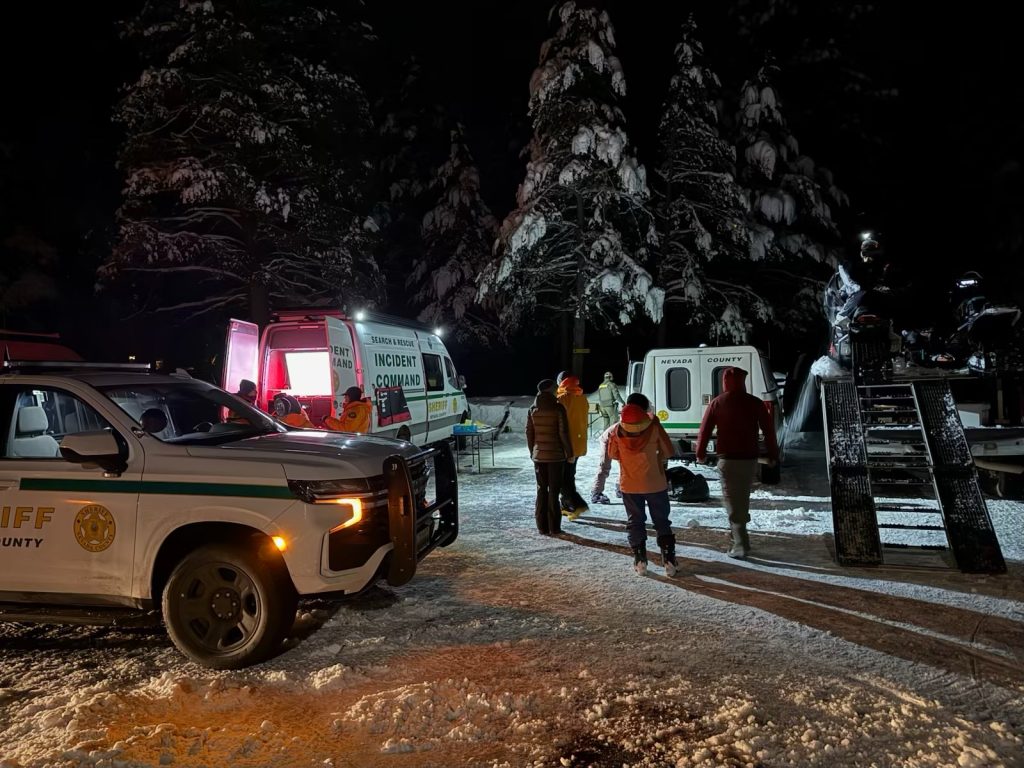
At the time of the call, the Nevada County Sheriff’s Search and Rescue (NCSSAR) team was already on an active call for a Placer County Sheriff’s Office missing person’s case but transitioned to the avalanche based on the possible level of severity. Tahoe Nordic Search and Rescue also immediately responded. A total of three SnoCats were deployed, along with three snowmobile teams and several ski teams.
This incident began when a group of five experienced snowmobilers set off for the day from the Johnson Canyon area and made their way successfully to Castle Peak. The group of five friends were all well-prepared for backcountry exploration, wearing appropriate protective equipment, including avalanche beacons/transceivers. Two individuals in the group are locals and know the area well (one is also CPR certified). The three others, including the victim, were visiting from Bend, OR (with another individual CPR certified).
On the group’s return from Castle Peak, an avalanche was triggered on the backside of the mountain, burying the victim, identified as Chris Scott Thomason, 42, of Bend, OR. The group immediately tracked Thomason’s beacon and began digging him out. After successfully retrieving him and beginning CPR, another group of three individuals, not affiliated with the group, came across the scene. One of these individuals happened to be an off-duty Truckee Fire medic who immediately began leading emergency efforts and CPR.
Despite the group taking several safety precautions and Thomason receiving high-level CPR, he did not survive the incident.
Search efforts concluded the evening of Jan. 5. All remaining individuals known to be in the area are accounted for and are safe. There are no other victims or outstanding persons.
Fireworks test to occur Thursday in Stateline
STATELINE, Nev. – In preparation for the U.S. 250th anniversary on July 4, 2026, Zambelli Fireworks will be conducting fireworks test runs on Thursday, January 8, between 4-6 p.m. in the casino corridor.
Zambelli Fireworks, headquartered in Pennsylvania, produces over 1,600 fireworks and pyrotechnic displays across the U.S. and internationally. The South Shore’s fireworks show, rated one of the Top 10 in the country, is sponsored by the Tahoe Douglas Visitors Authority.
The testing may be intermittent during the scheduled two hours, without traffic impacts expected.
South Tahoe High School graduate completes first year as NCAA Division I university head volleyball coach

SOUTH LAKE TAHOE, Calif. – For Shawn McLaughlin, a South Lake Tahoe native, being part of a team was something that came naturally.
Growing up in Tahoe, McLaughlin was accustomed to community involvement, watching as his father coached track and eventually varsity volleyball as the head coach at George Whittell High School.
“I used to joke that I was the youngest assistant coach in the country,” said McLaughlin. “I would just go around and help him keep stats.”
McLaughlin’s father was extremely successful as head volleyball coach, going on to win several state championships over his 18-year run at both Whittell and South Tahoe High Schools, allowing McLaughlin the opportunity to find interest in following in his footsteps.
Playing volleyball throughout his school years, McLaughlin was also part of a junior club team in the Bay Area before going on to play varsity volleyball at Lindenwood University in St. Louis.
After graduating from college, McLaughlin started volunteer coaching at a number of different schools including UC Davis, University of Nevada, Reno, University of the Incarnate Word, and more all around the country.
“My dad had a huge impact on my wanting to coach,” McLaughlin said, and pretty early on, he determined that a career in education was the direction he wanted to go in. “Volleyball is my means, in education, in growth and learning. I’ve always loved that element and I think that’s part of the reason that coaching has gone the way it’s gone.”
Among McLaughlin’s accomplishments, he brought many teams to their national tournaments through the club ranks. In addition, he won gold in 2014 at the USA Volleyball Junior National in 14’s USA. In terms of college, he’s been coaching for 15 years, winning several conference championships and attending the National Collegiate Athletic Association (NCAA) tournament several times.
En route to becoming a Division I (D-I) coach, the opportunity presented itself in the form of his father running a club and bringing in college coaches.
“One of the coaches he brought in was Jamie Holmes, she was at UC Davis. I approached her and said ‘How do I get into this?’ and she said, ‘come be my volunteer,'” said McLaughlin. “It was a great start to my program and a great start to my career and that pushed me into the rest of it.”
McLaughlin is now in his first headcoaching opportunity at Lehigh University, a D-I school in Pennsylvania, and with his first year completed, the competitive program is allowing him to utilize the skills he’s learned over the years assisting other D-I coaches. “Now this is my opportunity to be super successful and to run my own ship.”

Despite suffering a major injury, his team was still able to overcome adversity and make it to the Patriot League Tournament, an unprecedented accomplishment for Lehigh.
“I think 2026 could be a really fun year for this team,” added McLaughlin, and with seven seniors on the team, they are striving to be victorious.
Although McLaughlin is now soaring high as head coach, he doesn’t forget his roots, and continues to return to South Lake Tahoe every Christmas.
“[South Lake Tahoe] is one of the best places in the world to grow up. It’s also a very active community,” McLaughlin said. “It’s just home. It still feels like home to me.”
Juice It Up added to Cascade Kitchens with an eye towards additional location
SOUTH LAKE TAHOE, Calif. – Juice It Up, a brand known for smoothies, bowls and fresh-pressed juices, opened a limited kiosk operation inside Cascade Kitchens Food Hall in early December. The location is operating as a three-month test while owners work toward securing the final details for a full-scale store in the north part of town.
The kiosk model allows customers to order at the kiosk itself (or via their app, even the day before), with smoothies and food prepared fresh behind the scenes. While the setup lacks some of the full juicing equipment used in permanent locations, the husband-and-wife ownership team of Rebekah and Don Havard say it serves as a way to introduce the brand, build regular customers and demonstrate demand.
“This gives us a chance to prove the concept and not let the community down,” Rebekah said.
The decision to bring Juice It Up to Tahoe was influenced by nostalgia as much as opportunity. The owners were familiar with the brand from their years raising a family in Southern California, where Juice It Up first launched more than 30 years ago.

“It was always the place we went when we were running from one sports practice to another,” Rebekah added. “Juice It Up was always there as our stamp.”
After visiting family in Southern California, they were reminded of the business and felt it would be a fun addition to the food and beverage scene in Tahoe – an option that combines speed, convenience, healthy food, and a family-friendly feel.
If the kiosk proves viable, the plan would be to keep the location inside Cascade Kitchens, with a possibility of taking over a bay if one becomes available. But the overarching goal is to open their permanent location by summer, potentially sooner.
A full Juice It Up store would include fresh-pressed juices made on site from ingredients such as spinach, kale, apples and citrus, significantly expanding the menu beyond what the kiosk currently offers.
The brand’s menu focuses on smoothies, protein-rich drinks, acai bowls and toast options. Among the most popular items is “The Zone,” a smoothie containing 32 grams of protein marketed in-part toward customers seeking post-workout recovery. Seasonal and limited-time smoothies will also be available on a quarterly rotation.
Toast offerings include strawberry peanut butter crunch, avocado “everything” toast and peanut butter banana toast served on sourdough bread.
In addition to the Tahoe Juice It Up operation, Rebekah and Don are also the same ownership team behind several other local food businesses, including Chicken in a Barrel and The Baked Bear. While juggling multiple concepts can be demanding, the couple credit experienced managers and staff for making it possible.
“We wouldn’t survive without our team,” Rebekah said. “They care about the food, the customers and the environment. That makes all the difference.”
Beyond in-store sales, Juice It Up is also promoting catering, mobile events and fundraising partnerships. The business can provide smoothies for offices, schools and events, including fundraisers where organizations earn a portion of sales. The franchise already meets nutritional requirements for school districts in California.
Customers who order through the app receive loyalty rewards and promotional offers and new users receive a free smoothie for signing up, with additional rewards earned through repeat purchases.
Despite launching during winter – traditionally a slower time for cold beverages – the kiosk has already developed regular customers and the food hall itself has seen increased traffic in recent weeks, particularly from large groups. Rebekah added that the shared space allows families and groups to order from multiple vendors while dining together – a key part of the food hall’s original vision.
“That’s exactly what this space was meant for,” she said. “Everyone can get what they want.”
For now, the focus remains on making the kiosk successful and building community support.
“Our hope is to make this a permanent part of Tahoe.”
Juice It Up is currently located inside Cascade Kitchens Food Hall and Bar in South Lake Tahoe, CA. For more information visit them online at cascadekitchenstahoe.com/restaurants/juice-it-up/ or look for them on their social media channels.
Momentum for the Truckee Regional Library; North Tahoe Community Alliance Issues Call for Board Members; More
Top 10 Winter Activities in Lake Tahoe
South Lake Tahoe is a winter paradise offering a wide array of activities to complement its world-famous skiing and snowboarding. Whether you’re looking for high-thrill adventures or serene moments by a crackling fire, this guide covers the must-try experiences to make your winter visit truly unforgettable.
Explore the Outdoors
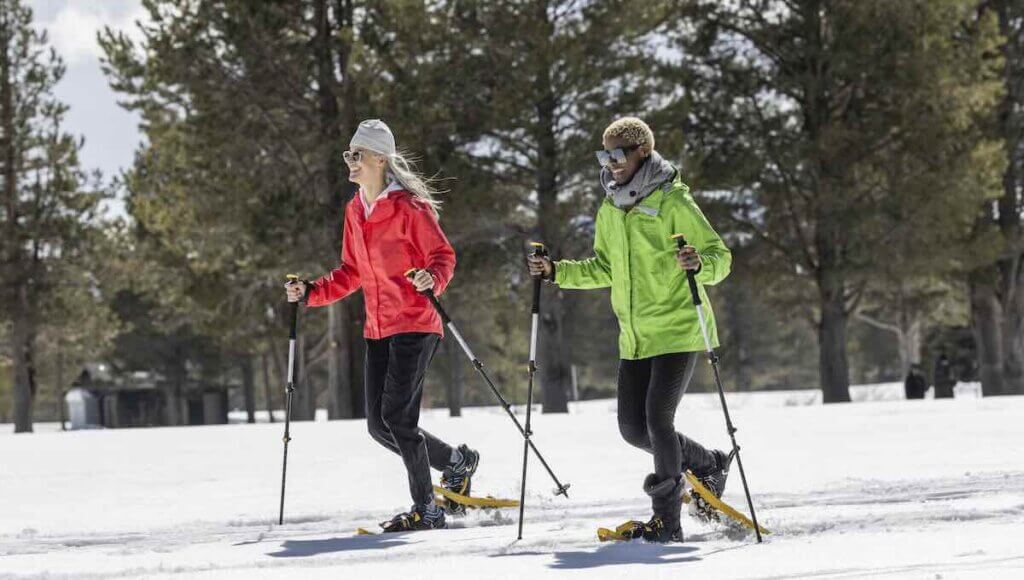
If you’re seeking an active way to take in Tahoe’s serene beauty, cross-country skiing and snowshoeing are perfect options. Hope Valley Outdoors, just south of town, features over 60 miles of trails winding through meadows, valleys, and mountain paths. These tree-lined routes offer sweeping views and a chance to connect with the snowy landscape. Explore gear rental shops here.
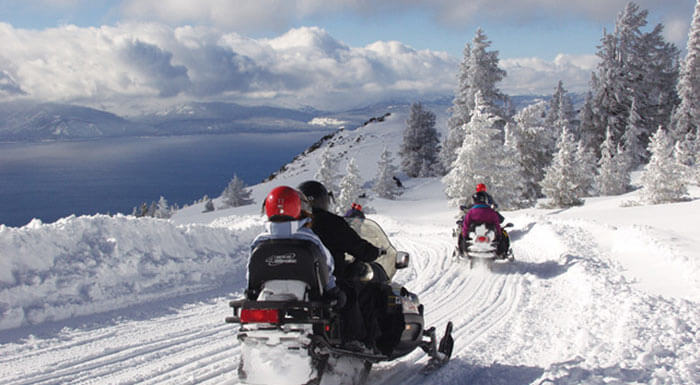
2. Snowmobile Adventures
Feel the rush of winter with a snowmobile tour through the snow-blanketed forests of South Lake Tahoe. Zephyr Cove Snowmobile Center provides access to breathtaking panoramic views at elevations nearing 9,000 feet. For family-friendly options, Tahoe Snowmobiles and Lake Tahoe Adventures offer tours suitable for all ages.
3. Tubing and Sledding Fun
Sometimes, the simplest joys are the most memorable. Sledding and tubing are perfect for families and thrill-seekers alike. Adventure Mountain Lake Tahoe offers machine-groomed sledding and tubing hills for all ages. Other great spots include Hansen’s Resort on Ski Run Blvd and Tube Tahoe at Tahoe Paradise Golf Course in Meyers.
4. Sleigh Rides
Complete your winter wonderland experience with an old-fashioned sleigh ride. Pulled by majestic draft horses, these decorated sleighs glide through snowy fields and pine forests, creating magical memories against Tahoe’s stunning backdrop.
Unwind and Relax
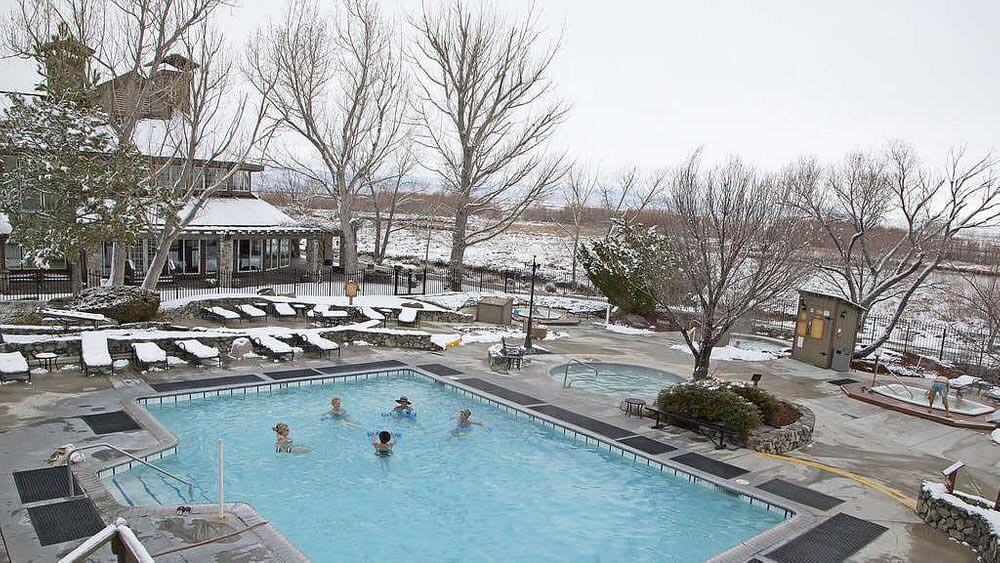
After a day of adventure, there’s nothing like soaking in natural hot springs. South Shore also has one of America’s only Japanese-style cedar bathhouses – learn more about this unique and nourishing experience here. There are a few different options, but for those seeking a little luxury, we recommend the trek to David Walley’s Hot Springs, a soothing retreat where you can relax in healing waters surrounded by the Sierra Nevada’s breathtaking scenery. Consider making a stop at Nevada’s oldest thirst parlor, the Genoa Bar & Saloon. Learn more about all of our spa options here.
6. Fireside Cozy Time
South Lake Tahoe knows how to do après-ski right. Gather around a fire pit with family and friends to toast marshmallows, sip hot cocoa, and share stories of the day’s adventures. From boutique coffee shops to cozy mountain lodges, you’ll find plenty of spots to warm up and create lasting memories.
Indoor Adventures

7. Indoor Rock Climbing
Even when it’s snowing outside, you can climb to new heights indoors. Blue Granite Climbing Gym offers year-round climbing opportunities, from beginner-friendly walls to advanced challenges. Classes, clinics, and youth programs make this a must-visit spot for climbers of all skill levels.
8. Learn to Curl
Channel your inner Olympian with a curling session at the Lake Tahoe Ice Arena. Lake Tahoe Epic Curling offers Sunday evening “Learn to Curl” classes, as well as private group events. It’s a unique way to bond with family or friends while trying something new on the ice.
9. Axe Throwing
Looking for something a little different? Head to Yosemite Axe Throwing for a fun and exciting indoor activity. Perfect for groups or solo adventurers, this thrilling pastime lets you channel your inner lumberjack while staying warm and dry.
10. Mini Golf and More at Tipsy Putt
Tipsy Putt combines mini-golf fun with a laid-back vibe and a fantastic drink menu. It’s a great indoor option for families during the day or for adults looking to unwind in the evening. Enjoy some lighthearted competition while escaping the winter chill.
Bonus: See Lake Tahoe From The Sky
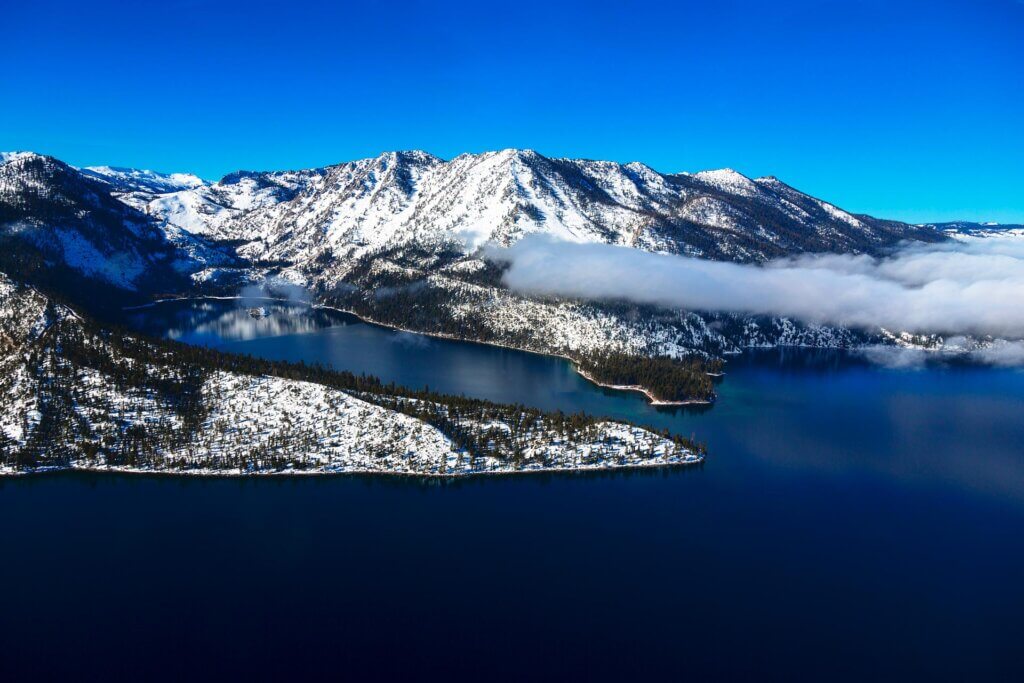
There are so many ways to see the richness of Lake Tahoe, but what about from the sky? The expert pilots from Tahoe Helicopters offer you the opportunity to see iconic sights. Imagine the beauty of Emerald Bay, Fallen Leaf Lake, Desolation Wilderness, Crystal Bay or Sand Harbor from thousands of feet above. They offer all kinds of flights, including an hour-long sunset tour. Be sure to bring your camera and be the envy of all your friends.
South Lake Tahoe has something for everyone during the winter season. From adrenaline-pumping snowmobile tours to serene hot springs, your days here can be as action-packed or laid-back as you choose. So, pack your snow gear, plan your perfect winter getaway, and experience the magic of Tahoe like never before.
The post Top 10 Winter Activities in Lake Tahoe appeared first on Visit Lake Tahoe.
How To Traverse Heavenly Mountain Resort Like A Pro
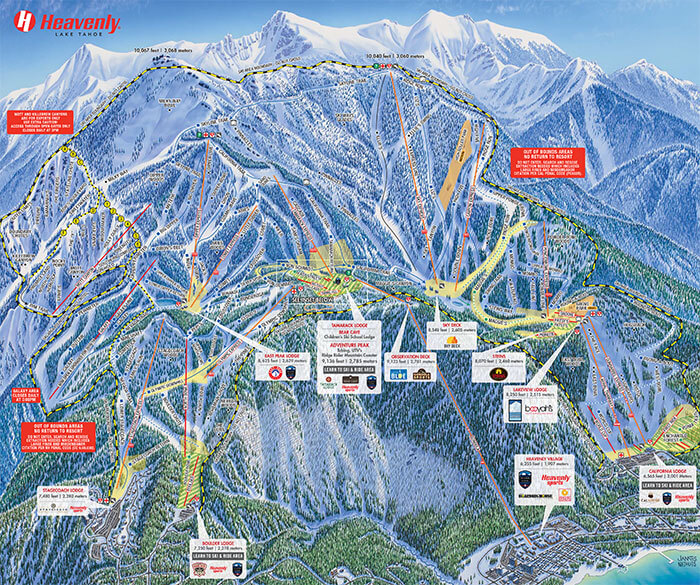
Lake Tahoe’s Heavenly Mountain Resort is BIG! In fact, with a vertical of over 3,500 feet spanning 4,800+ acres, it’s not surprising that it’s one of the top 10 largest resorts in North America. With so much acreage, Heavenly has something for everyone. From well-spaced trees, a multitude of easy-going cut ski runs, two canyon areas with challenging chutes (Mott and Killebrew), and one true alpine bowl (Milky Way), you’ll never say that Heavenly is a boring place. For first timers though, visiting this hulking brute of a resort can be downright frustrating. Don’t worry, we’re to help! With a little bit of planning and guidance, you’ll be able to traverse this mountain like a pro, reducing the stress and increasing the fun.
For the most up-to-date lift and terrain status visit SkiHeavenly.com or the EPIC app.
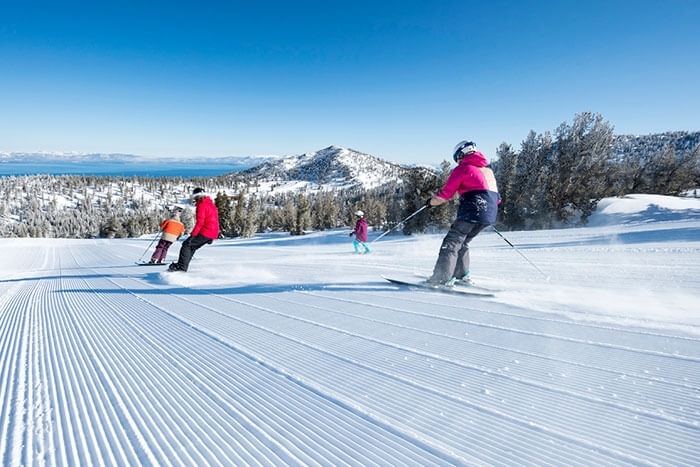
Skyline (Top of Sky Express To Dipper)
So, you’ve skied all the terrain around Sky & Canyon Express lifts and want to check out the Nevada side of the mountain. To do this, you’ll need to take the Skyline trail from the summit of the Sky chairlift. Be forewarned… keep your velocity and don’t get distracted by the lake views to your left. At over a mile in length, you need to pass the entrance to the Pinnacles and still keep going forward. You know you’ve made it once you see the Dipper chairlift, otherwise, keep that acceleration up.
Comet/Crossover (Comet Express to Stagecoach)
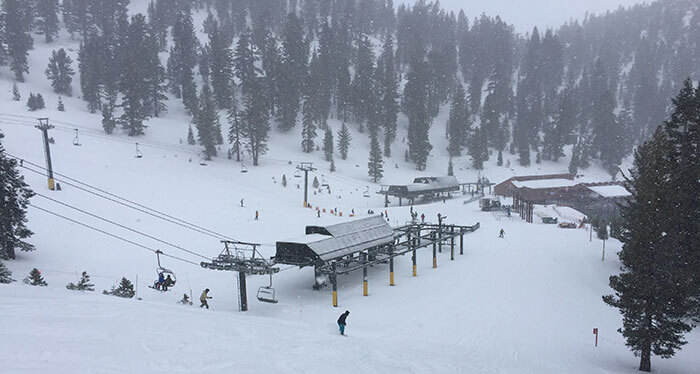
Comet & Dipper offer skiers and snowboarders fantastic views of the Carson Valley below and great groomers to lay out some turns. If you make it to this side, don’t miss the Olympic Downhill trail. Stretching over 5.5 miles and covering nearly 2,000 vertical feet, it’s the perfect option for those who want to carve to their heart’s content. To get to it, you’ll need to take the Comet trail (off of the aptly named chairlift) and blast your way onto Cross-over. DO NOT slow down, otherwise, you’ll be walking or skating the entire length until you get to the top of $100 saddle. From here, you’ll schuss your way to the bottom of Olympic.
Pepi’s (Top of Stagecoach To Dipper)
From the top of the Olympic Express, take a right and proceed onto the Olympic Downhill trail. This run will get your legs burning as you wind your way all the way down to the base of Stagecoach Express. For those that want to get back to another part of the mountain, the traverse from the top of Stagecoach via Pepi’s is a challenging one. The easiest of the two options is to ski to Upper North Bowl and take Olympic Express up. From there, make a left onto Von Schmidt’s, which will let you drop back into the Dipper/Comet base area easily. The second and more direct route would be to take Pepi’s from the top of Stagecoach. This is another flat route, meaning you need to keep your speed up, or you might end up walking again.
California Trail (Top of Dipper To Sky)
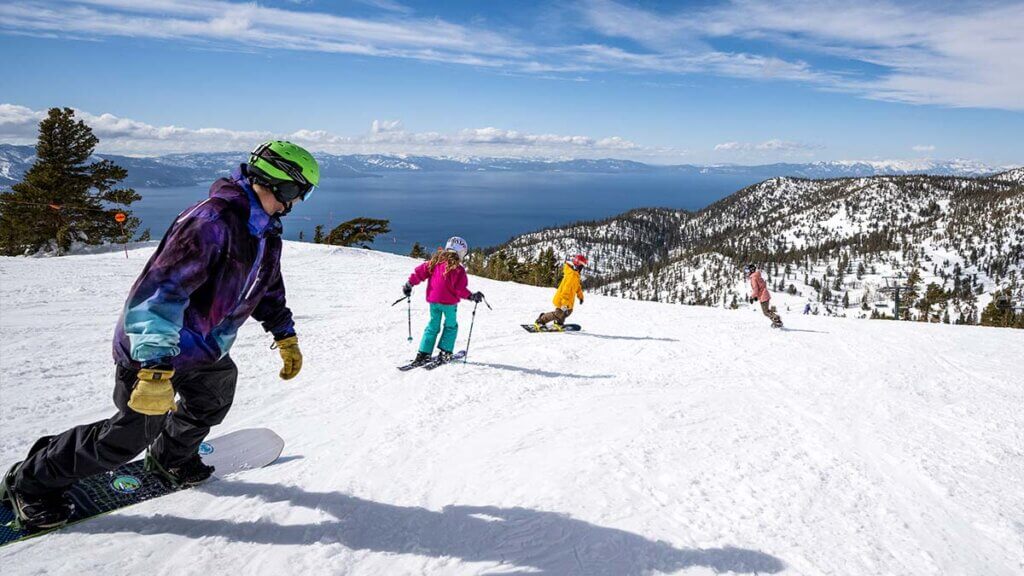
After so much skiing and snowboarding, your legs are done for the day. The problem is you’re still in the Nevada area. From the top of Dipper, you’ll want to head skier’s left onto the California trail. Keep up your speed until you pass the Tamarack chairlift overhead. From there, you can let yourself relax and link some turns. Take a tight left turn as you ski past the Tamarack/Gondola area. You’ll need to make sure you keep the momentum going. This long traverse can be deceptive, leading to you not reaching the bottom of Sky.
Being the largest and highest ski area in Lake Tahoe, Heavenly Mountain can be challenging to navigate. Instead of getting frustrated, be sure that you have a plan. If you do, you’ll make your time on the mountain “Heavenly.”
Weekend and peak period parking reservation information.
Check out all the Ski Resorts on the South Shore here.
Check out Heavenly Mountain Resort on Instagram
The post How To Traverse Heavenly Mountain Resort Like A Pro appeared first on Visit Lake Tahoe.
Slow Start to Ski Season Affects Local, International Workers; Firefighter Family Assistance Efforts; More
The Ultimate Guide to Group Dining in South Lake Tahoe
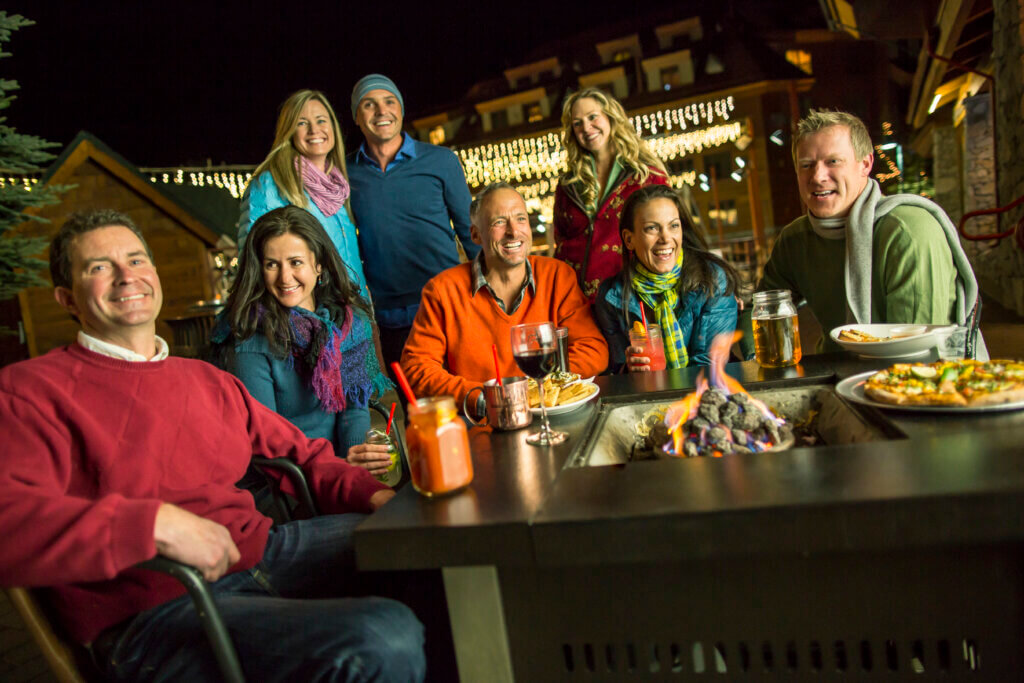
Whether you’re team-building over craft brews or savoring dungeness crab cakes lakeside, you can experience the true mountain hospitality only found in South Lake Tahoe. Nestled amid the continent’s largest alpine lake and the snowy peaks of the Sierra Nevadas, there’s a reason why the South Shore is a highly sought-after destination for events of all kinds.
You can book space at flexible indoor and outdoor venues, fully convertible sports arenas, and advanced facilities. From the Tahoe Blue Event Center, our state-of-the-art sports complex, to ample meeting rooms at mountain resorts, cozy lodges, and boutique hotels, we have a venue for what you need. Choose from 143,000 sq. ft. of event space options, 10,000+ hotel suites, 365 days of outdoor activities, and a 24-hour entertainment scene all in one place. Plus, you’ll be within walking distance of thrilling nightclubs, scenic views, and diverse restaurants.
Speaking of diverse restaurants, the following dining establishments and catering services are designed for groups in town to take care of business or take home a championship.
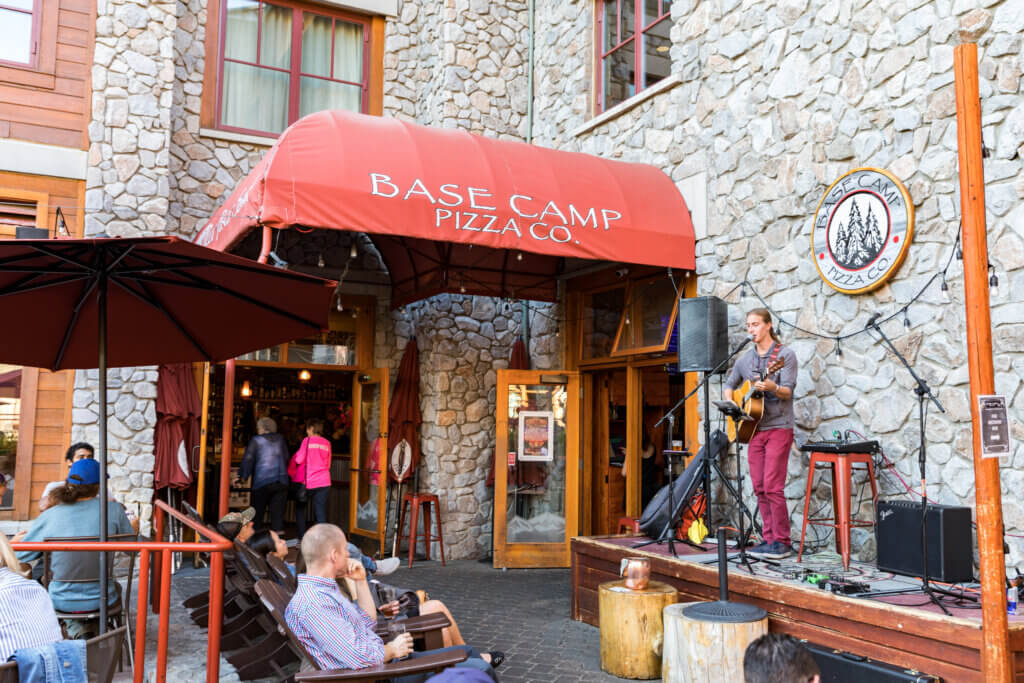
Private Rooms
With these standalone spaces, you can move about freely and enjoy the team-building experiences that arise from sharing meals with one another.
Perched atop a hill overlooking Lake Tahoe, Chart House is a legendary seafood restaurant boasting a private banquet room. With lunch, dinner, and buffet packages, your guests can soak in the views while enjoying the freshest of dishes and the friendliest of service.
Who doesn’t like pizza? Every pie at Base Camp Pizza Co. is crafted with locally sourced ingredients. They also offer “that unmistakable Tahoe vibe” and dedicated space for up to 60 people. And sure, Karen can get a salad here too.
Tucked away inside The Lodge at Edgewood Tahoe Resort, you’ll find a 442-sq. ft. private dining with a patio for up to 30 guests and an exclusive 418- sq. ft. board room space complete with fireplace, private bathroom, and patio for up to 12 guests. Relish gourmet dining, unwind at the spa, play a round of golf, hit the slopes, or stay the night at this all-in-one luxury resort property.
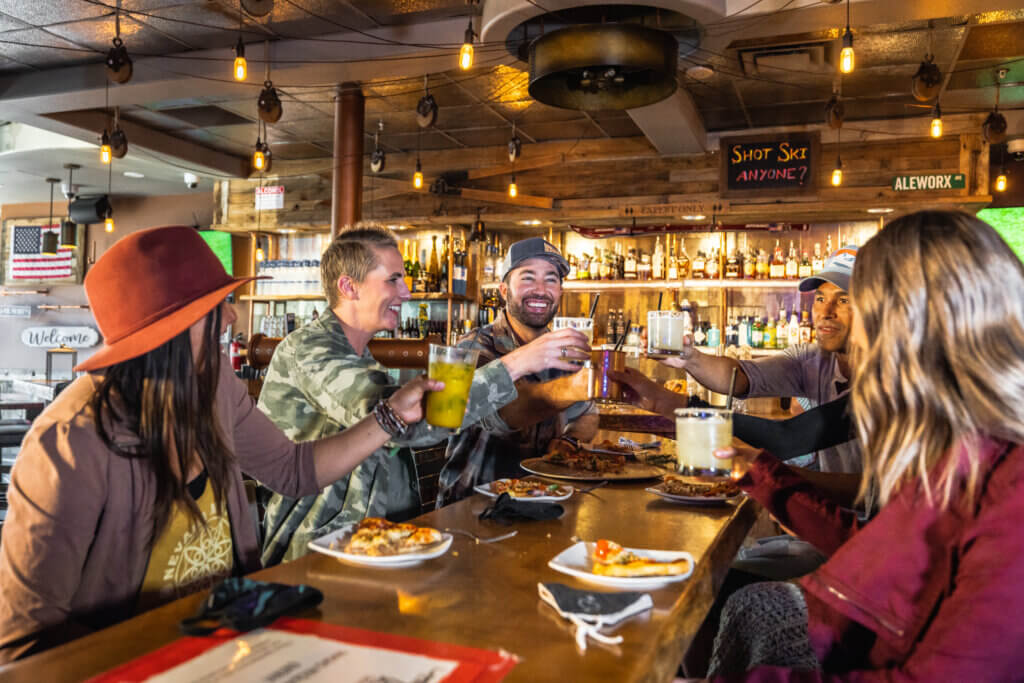
Whole-Restaurant Takeovers
Let’s just say you have a party-of-five and then some. Below are a few establishments that can handle your wild bunch, no matter how large (and in-charge).
Try California-style Mexican, a lighter take on Mexican and South and Central American cuisine, made with primarily organic and sustainable ingredients, as well as craft cocktails made with fresh-squeezed juices. Azul Latin Kitchen can accommodate parties of 20-50 or a full buyout for up to 120 guests. Its sister restaurant, California Burger Co., has the same accommodations with a menu of local ingredients, a curated selection of rotating drafts, and buns baked daily.
Taste one of the best wurst restaurants in the state. Himmel Haus is a German eatery and bierhaus featuring a wide variety of drinks and a simple menu of Bavarian-inspired food. Your party of 30 or whole-restaurant buyout of 80 will fit in just fine—with or without the lederhosen.
You and up to 400 of your closest attendees can overtake the entire Lake Tahoe AleWorX, an award-winning establishment serving wood-fired pizza, craft beer, cocktails, salads, and classic pub food. Trust us, you’ll savor the scenery just as much as what’s on your plate.
Catering Constants
Let our local gems cater to you on every level. Find meals that are built for fueling corporate retreats and teams hungry for victory.
Lake Tahoe’s only Scottish Pub, MacDuff’s Public House, serves from-scratch, locally sourced Scottish favorites and handcrafted cocktails. Their catering services are available onsite, offsite, and at their private venue called The Barrel Room.
Bella Tahoe is an award-winning and critically-acclaimed catering company with everything from specialized brunches cooked on-demand to five-course buffets and takeaway boxed meals to full-service catering options that are all customized to your event’s specifications.
Indulge in the rich flavors of Tahoe’s newest dining experience. Featuring large-party catering and private dining options, the menu at Primo’s Italian Bistro showcases a modern, innovative approach to Italian cuisine. Sip on Italian varietals alongside distinguished California wines, signature cocktails, inventive mocktails, and craft beers. Bonus points for checking out their late-night menu.

Diverse Diets
Whether it’s gluten-free, dairy-free, vegan, or vegetarian, we don’t think of them as restrictions so much as opportunities for true innovation. Here are some South Shore favorites offering allergen-friendly selections and adapted menus based on dietary preferences.
Sprouts Natural Food Café prepares healthy, organic, gourmet meals with vegan, vegetarian, and gluten-free options that are clearly labeled. Add some color to your plate and feel good about what you’re eating even while you’re away from home.
My Thai serves up mouth-watering, authentic Thai cuisine that allows you to choose your preferred protein and provides a specialty veggie menu. You can also choose your own adventure with each dish’s spice level.
Consistently voted Best Coffee in South Lake Tahoe, Cuppa Tahoe is a coffee shop, bookstore, and private co-working space ideal for executive breakouts and boutique meetings. Their seasonally rotating menu includes several mouthwatering, plant-based items. We recommend the Vegan Hot Mess.

Let’s Meet (& Eat)
One thing’s for sure: you should save room for excellence. Transcend your agenda and satisfy your cravings at the same time in South Lake Tahoe. Browse South Shore venues designed for games, meetings, and conventions of all sizes. You can also scroll through this handy group pamphlet for more reasons to fall in love with the lake.
At 6,224 ft. above sea level, everything is elevated here—including your next event. Attendees will leave feeling so invigorated and satiated, the only problem you’ll have will be convincing them to board their returning flights (which is a great time to mention that we’re just a short drive away from Reno-Tahoe International Airport).
Already like what you see? Send us your RFP. (We promise not to rhyme anymore than that.) Let’s set the table for your success.
The post The Ultimate Guide to Group Dining in South Lake Tahoe appeared first on Visit Lake Tahoe.
Host Your Winter Sporting Event in South Lake Tahoe

From the NHL Outdoors to the Grand Slam of Curling, South Lake Tahoe is no stranger to the world stage, especially when it comes to winter sports. Thanks to a diverse array of indoor and outdoor venues, fully convertible sports arenas, and advanced facilities, you can host any type of competition throughout the year. Nothing compares to the South Shore; find out exactly why below—and start practicing your victory lap.
All-Star Facilities
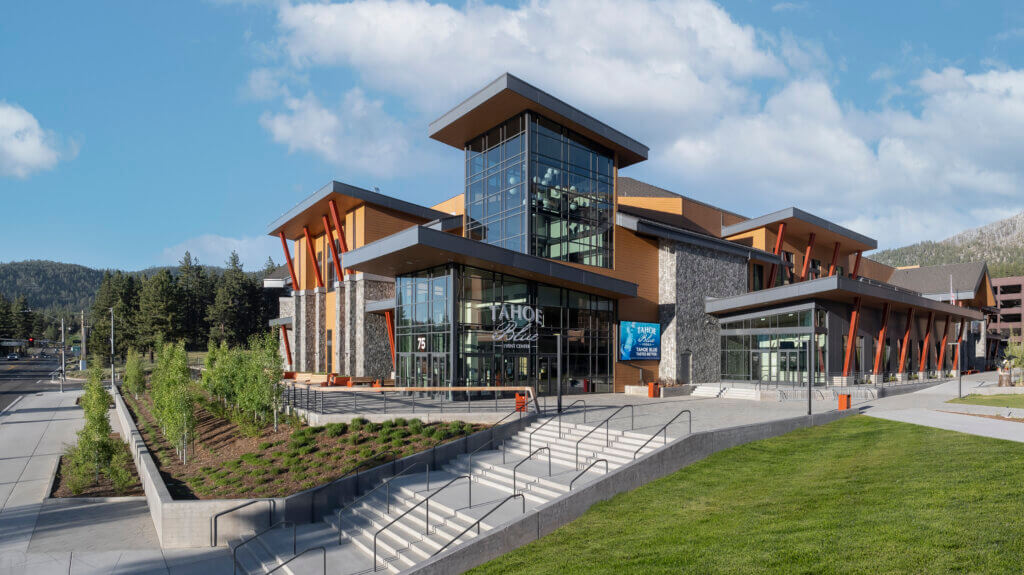
When it comes to venues, the Tahoe Blue Event Center is your MVP. This state-of-the-art sports complex features an NHL-regulation-sized ice rink, NBA regulation-sized basketball court (that can be converted into a volleyball court), and a multi-purpose arena designed for wrestling, gymnastics, and cheerleading. Basically, if the sport exists, you can probably play it here. The ~27,000 square feet of arena floor space can be configured to accommodate curling, hockey, and figure skating, to name a few. Browse additional specs and capabilities with this handy Tahoe Blue Event Center chart.
Home to an ECHL ice hockey team known as the Knight Monsters, Tahoe Blue Event Center has hosted professional games, concerts, trade shows, conferences, banquets, comedy acts, and various live performances—all with streamlined logistics and top-notch amenities included.
Speaking of logistics, talk about a smooth operator: the center’s multiple locker rooms, exclusive suites, club seats, and spacious back-of-house designated areas are ready for whatever your playbook holds. With seating for around 4,000 fans, modern sightlines, and multiple concourse spaces intended for vendor booths, concessions, and merchandise shops, at least your choice in venues will be a guaranteed win.
Post-Game Experiences

When you’re in South Lake Tahoe, the adrenaline rush continues long after the buzzer sounds. For starters, enjoy the country’s highest concentration of ski resorts within a 100-mile radius. Or come back for another season to take a hike alongside hidden waterfalls, stunning peaks, and lush meadows. You can also roll through our mountain bike trails, with family-friendly paths for starter cyclists to technical climbs for advanced riders. Of course, there are plenty of courses: golf in view of the Sierra Nevada’s granite peaks or along the lake’s shore. South Lake Tahoe’s 300 days of sunshine per year and fresh alpine air will invigorate your athletes’ bodies and minds.
Oh, so you like the nightlife? You like to boogie? We knew you had great taste. Good thing you have full access to 24/7 entertainment. The South Shore holds a trove of craft breweries, lakefront restaurants, casinos, savory steakhouses, vibrant nightclubs, serene beaches, and eclectic shops, all within walking distance of your venue or hotel. How convenient. And while we always keep the South Shore updated, we also contain rich history. Walk in the footsteps of Mark Twain, visit a castle, or dive into our underwater state park to scope out a shipwreck.
South Lake Tahoe has also covered your bases when it comes to top-rated, family-friendly activities. Have your kiddos done enough outdoor adventuring for the day? We get it. The Puzzle Room Tahoe, magic shows at The Loft, all-ages games at multiple arcades, and indoor-mini golf are sure to keep them occupied (and wear them out before bedtime).
You Call the Transportation Shots
This isn’t your average sporting event destination, so we don’t have your average transportation. Lake Link, a free microtransit shuttle system, provides on-demand rides 365 days per year, from 7 a.m. to 9 p.m. (and until 10 p.m. on Fridays and Saturdays). Equipped with bike and ski racks, the shuttles include wheelchair accessibility and supplemental services.
We’re also only a short drive away from Reno-Tahoe International Airport, with a direct airport shuttle, the South Tahoe Airporter, at hand when you need it most. And the Tahoe Transportation District (TTD) recently expanded its Route 50 Express Service to offer rides for select Tahoe Blue Event Center events as well as late-night rides on the weekends. This extended service provides convenient, reliable, and free transportation, supporting a variety of events for both locals and visitors alike.
Make the most of your time here with scenic tours and bus rentals. The fleet consists of three luxurious, 28-passenger mini-coaches for local, regional, and statewide destinations. Plus, our company is the only one to ever offer tours from Lake Tahoe to San Francisco and Yosemite National Park. You can book bus charters and rentals for all occasions, such as weddings, corporate events, airport transfers, and private tours.
Where Sports are Always in Season
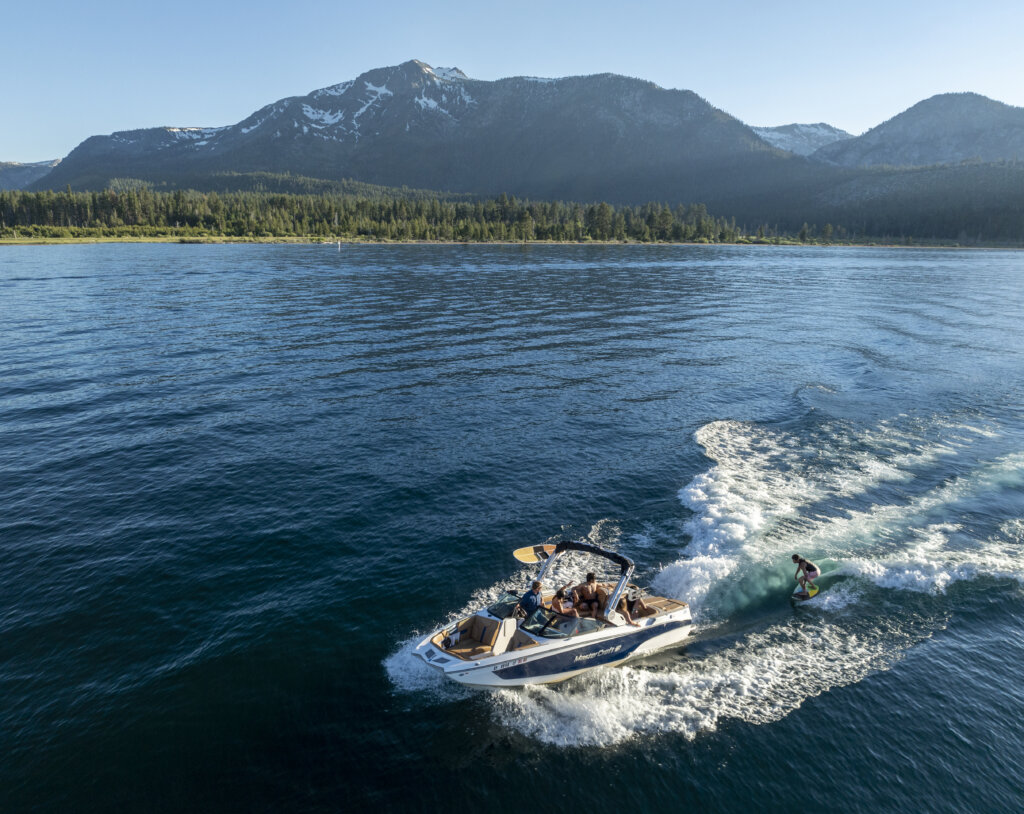
At 6,224 ft. above sea level, everything is elevated in South Lake Tahoe. We keep you at the top of your game 365 days a year, 24 hours a day. Nestled amid the continent’s largest alpine lake and the snowy peaks of the Sierra Nevadas, it’s easy to see why the South Shore is a highly sought-after event destination. Browse our starting lineup of sports venues and see for yourself.
The post Host Your Winter Sporting Event in South Lake Tahoe appeared first on Visit Lake Tahoe.
TBID Renewed for 10 Years; Kiley On TTUSD Leaving Nevada’s Athletic Association; Request for Proposal for Lift Truckee’s Workspace; More
What to do in Tahoe while waiting for Snow
We all know Lake Tahoe is famous for its skiing and snowboarding scene. But what if you want to take a break from that and do something else. Or maybe the snow hasn’t come yet? Well, of course, you can still ski on man-made snow and the experience is great. However, there are a ton of things to do in Tahoe during the winter months that don’t need getting on a chairlift.
1. Lake Tahoe Cruise
Tahoe’s blue is best experienced from a boat. Book one of the Tahoe cruises and immerse yourself in the crisp mountain air and the blue water. Seeing the shores from a boat gives you a completely different experience. Your experience will be unique, whether you decide to do a morning cruise or a sunset cruise.
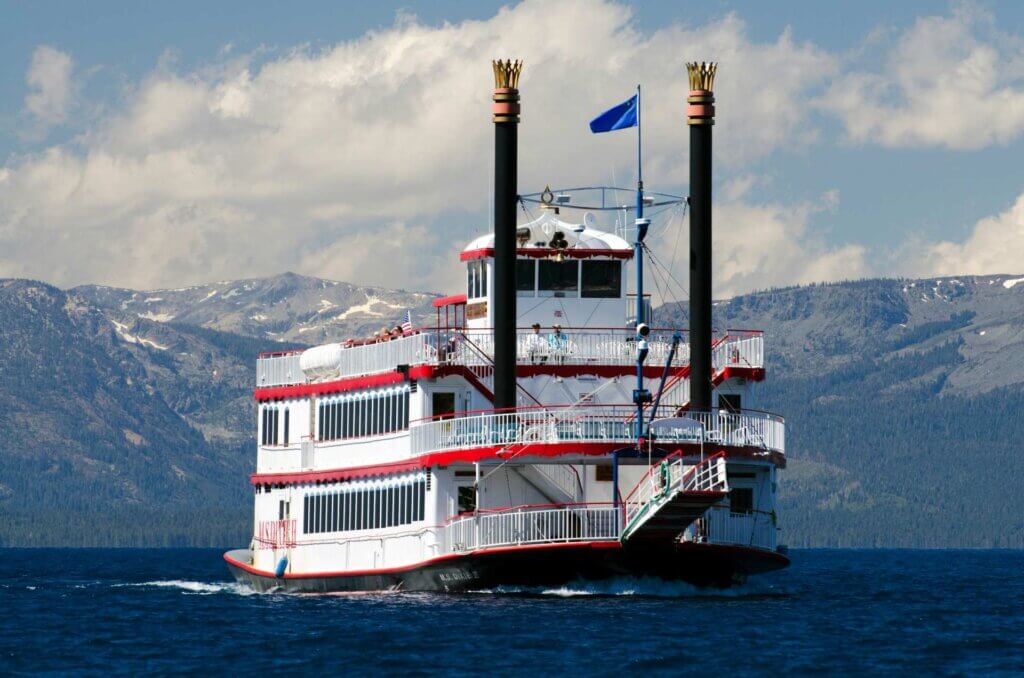
Some of the most memorable (or maybe not-so-easy-to-remember but definitely fun!) times are had on board a Lake Tahoe boat tour. Check out the M.S. Dixie II, the Tahoe Bleu Wave or the Spirit of Tahoe. Enjoy great food, great drinks and even better people aboard one of these South Lake Tahoe boat tours.
2. Hit the Spa
Pampering the body as well as the soul is almost a rule when it comes to visiting Lake Tahoe. Pick one of the many spa options Lake Tahoe offers and indulge yourself. Besides getting a massage or a facial, pick some goodies from the spa for yourself or for gifts for your loved ones for the holidays.

3. Night Out
When you feel like you need some more action in your life, plan on an evening out. In December, the Heavenly Village is having full three weeks events culminating with a New Year’s concert. So, pack something warm in your bag and head out for a fun evening.
4. Night Life
If you missed the party at the Heavenly Village, don’t worry. There’s always something to do in Lake Tahoe in the evening. Check out the casinos if you are into gambling, or go see music. Comedians, musicians, and excitement await you.

5. Ice Skating or Sledding
So what if the snow isn’t perfect right now? The entire family can have a blast ice skating or sledding in Lake Tahoe.
6. Hiking
Tahoe is always a great place to go hiking or snowshoeing. A few popular hikes are in Lake Tahoe that allow for amazing photography. Whether your spirit animal is more Instagram influencer than John Muir, you’ll find your favorite Lake Tahoe hiking trails on the south shore.
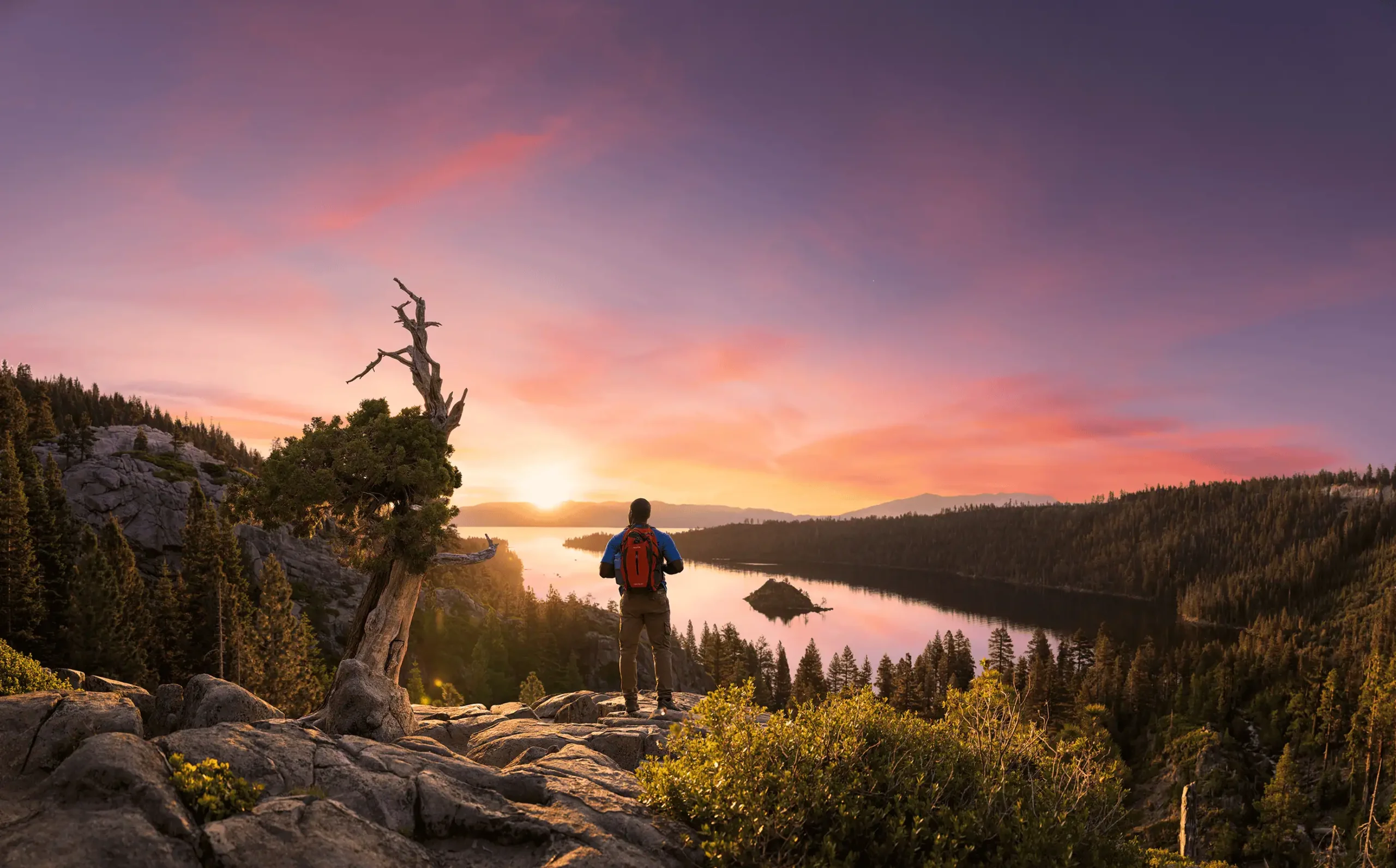
7. Take the dog to the beach
South Lake Tahoe is a dog-friendly heaven. Why not bring the pooch with you to experience the lake. From gourmet pet stores to dog-friendly hikes and beaches, there’s plenty to explore. Check out this blog post for more details.
8. Just enjoy the Lake
Sit on the beach or at a lakefront restaurant and take it all in. Whether you are into meditation or not, the lake will calm your senses and relieve the stress. Then, you can go home refreshed and ready to enjoy the holidays.
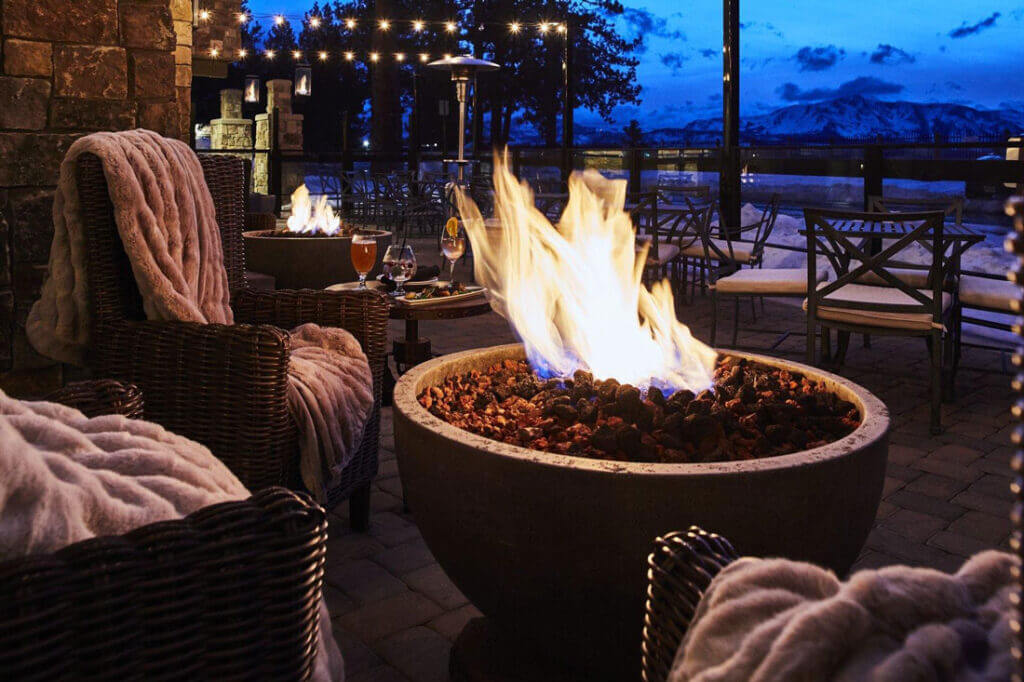
The post What to do in Tahoe while waiting for Snow appeared first on Visit Lake Tahoe.
Tahoe/Truckee’s News of Note in 2025
Another year in the books.
Instead of jumping ahead to all things 2026, we at Moonshine Ink decided to revisit some of 2025’s most top-of-mind stories for our region and see what has (or hasn’t) changed.
Below, you’ll read about the latest regarding Tahoe lead cables, North Lake Tahoe incorporation, fire insurance, and the Town of Truckee’s self-reflection.
Lake Tahoe is (Finally) Lead Cable-Free
Follow-up to Lead-Sheathed Telecommunication Cables Removed from Lake … (News Briefs Nov. 25, 2024) printed Dec. 12, 2024, and other investigative stories in prior years
Almost five years since a lawsuit was first filed to remove two lead-leaking telecommunications cables from Lake Tahoe, the cables are fully and completely gone.
This one deserves some historical context:
Back in November 2020, Moonshine Ink broke the news that two four-inch-thick telecommunications cables existed beneath Lake Tahoe’s surface, actively leaking lead into the water — and that legal action was being taken to do something about it.

The intervening years have been somewhat of a rollercoaster. The lawsuit, filed in January 2021 by California Sportfishing Protection Alliance, initially resulted in a settlement by cable owner AT&T that fall. The company agreed to remove the cables, though denied they generated pollution.
Obtaining permits lengthened the removal process. Finally, AT&T planned for fall 2023. But a July 2023 Wall Street Journal investigation found the publicly traded corporation had a legacy of lead-clad infrastructure across bodies of water in the U.S., resulting in a freefall of AT&T stock and the company backtracking on removing the Tahoe cables until more lead testing could be done. (We reported on this, too.)
In September 2024, AT&T settled. By the end of that November, 8 miles of cables were pulled out of Lake Tahoe, though a segment remained due to its proximity to a sensitive habitat to the Tahoe yellow cress.
A year after that removal, on Sept. 18, 2025, the final phase was completed. AT&T worked in coordination with the USDA Forest Service Lake Tahoe Basin Management Unit to pull out the obsolete cable from Rubicon Bay to Baldwin Beach.
“Good weather and calm lake conditions allowed AT&T’s contractor to pull the remaining 100-foot section of cable with minimal impact to Baldwin Beach and Lake Tahoe,” shared USFS Public Affairs Specialist Lisa Herron in a statement. “Forest Service staff were on site throughout the operation, monitoring work to protect habitat for Tahoe yellow cress, a plant found only on Lake Tahoe’s shoreline.”
The League to Save Lake Tahoe (Keep Tahoe Blue) was also involved with the lead-cable removal.
“Taking out these decades-old, unused cables has been a top priority for Keep Tahoe Blue and the community as a whole. We’re proud to have helped make it happen and grateful to everyone who contributed,” said Laura Patten, natural resource director at Keep Tahoe Blue. “Good things happen in Tahoe when unlikely partners come together for a shared purpose.”
History in the Making for North Tahoe
Follow-up to Coming Soon: The Town of North Lake Tahoe? by Melissa Siig, printed March 13, 2025
It took a little over two months for a grassroots organization called Eastern Placer Future to collect what should end up being enough signatures to advance the idea of a Town of North Lake Tahoe closer to the incorporation finish line.
To commence an official exploration of becoming a new town by Placer County’s Local Agency Formation Commission (LAFCO), Eastern Placer Future needed to collect 2,188 signatures (or 25%) from certified voters within the proposed town boundary. During the last week of November, a third-party consultant verified the group collected 2,387 between September and mid-November.
This is the first time such an effort has progressed so far, despite multiple efforts dating as far back as 1966.
Steve Teshara, one of the Eastern Placer Future committee members, contributes the current success to waning influence of the Lake Tahoe portion in Placer County. District 5, which includes Tahoe’s North and West shores, is 77% of the county’s land area, but its population is not rising. Western Placer’s is.

“[District 5 Sup.] Cindy [Gustafson]’s probably the last supervisor that will be a resident of this area,” Teshara said. “That’s a central concern that we’re expressing to people, and people are resonating with that … People want to see where does our money really go, what do we get back, and are there some services that we could do better because they would be all coordinated locally? We’ll still have services provided by the county … like health and human service and a court system and things like that. And we may do some work and contracting with the county to start with, but people are really getting the sense that this is an opportunity to put in place local decision-making.”
But there’s a long way to go before anything becomes official.
During the first week of December, an Eastern Placer Future representative delivered the petitions to the LAFCO office in Auburn and then accompanied LAFCO staff to take the petitions to the Placer County elections office, which has 30 days to review.
“[The elections office is] the final arbiter of whether we’ve got the requisite number of signatures … We do expect to qualify for the petition being certified as valid,” Teshara said.
Assuming all systems are go, LAFCO will review an official Eastern Placer Future application (the group is currently raising $25,000 for a downpayment connected to this) and then put out a request for proposal for a comprehensive fiscal analysis. An environmental analysis will be considered separately.
“And then LAFCO looks at all the pieces, and they make a determination based on do they think that the town would be financially sustainable over a period of time, not just for a couple of years,” Teshara said. “They have to make sure that it’s an efficient way to provide government services in our area.
“Once they go through all that, then ultimately it has to go to the county for discussions, and finally some sort of county vote on the revenue neutrality negotiations.”
Eastern Placer Future funded an initial feasibility study for incorporation back in 2023. Based on Placer County costs and revenues for fiscal year 2021/22, Eastern Placer annually generated about $16.4 million in property tax; about $3.2 million in sales tax; $22.7 million in Transient Occupancy Tax; $2.1 million in property sales; and $862,000 from utility and service providers. The comprehensive fiscal analysis through LAFCO will create more accurate numbers based on recent costs and revenues, though Teshara said Eastern Placer Future anticipates there being enough funding to operate the town.
“A main way that LAFCO judges viability is it determines what your general fund revenues are,” he said. “If you have a general fund surplus of a certain percentage, that is a very helpful sign and metric. We anticipate that being the case.”
Should the Town of North Lake Tahoe (or whatever its official name might end up being) incorporate, it must do so without any harm to the county. Also part of the LAFCO process are revenue neutrality negotiations. “The county will pass through to the town the property tax, the sales tax, the other things that would be legally accruable to the town, but the county can’t lose a bunch of money based on this,” Teshara explained.
Assuming LAFCO approval, then board of supervisors’ approval, voters will step in to decide. To pass, it will take a 50%-plus-one ballot vote of registered voters within the proposed boundary. Regarding whether such a vote could happen as soon as November 2026, Teshara said, “All I can say is that we’re pushing as hard as we can to get through the process. Does the process take time? Are timelines stipulated under state law that LAFCO has to abide by? Yes.”
As the target is a moving one, Teshara said the best place for the latest updates is easternplacerfuture.org, which will have information about upcoming meetings, donation needs and milestones, and progress points.
A Fiery Dance Over Fire Insurance
 Follow-up to Understanding the Shortcomings of the California FAIR Plan by John Manocchio, printed March 13, 2025
Follow-up to Understanding the Shortcomings of the California FAIR Plan by John Manocchio, printed March 13, 2025
When Moonshine dove deep into fire insurance in September 2023, the mood — and situation — was dire. That year, most insurance giants (Farmers Insurance, State Farm, Allstate, Liberty Mutual) began limiting coverage in California in reaction to increasing wildfire concerns. As options shrank for homeowners and commercial tenants, many Californians began turning to the FAIR (Fair Access to Insurance Requirements) Plan, the state’s insurer of last resort at higher costs. One Truckee resident told the Ink at the time that her premium through the FAIR Plan shot her monthly payment up by 272%, from $1,800 to $6,700.
Looking back at that time from the end of 2025 reveals that such increases were only just beginning. From October 2024 to September 2025, the FAIR Plan acquired 268,379 new dwelling and commercial policyholders. That’s a nearly 200% increase from the October 2022 to September 2023 timeframe.
The FAIR Plan was enacted in the late 1960s to offer insurance to those unable to find coverage through traditional routes. As of September this year, the plan’s total policies in force (or the number of active policies) is 645,987 — a 96% increase since September 2023.
Further, the FAIR Plan’s total exposure following the same timeframes is $696.1 billion (a 52% increase since last September, and 145% increase since 2023). Back in March 2024, FAIR Plan president Victoria Roach said to a state legislative committee, “We are one event away from a large assessment. There’s no other way to say it, because we don’t have the money on hand [to pay every claim] and we have a lot of exposure.” That event, as it turned out, seemed to be the January 2025 Los Angeles fires, which resulted in an estimated $4 billion loss for the FAIR plan. In February, plan policyholders were assessed $1 billion to recoup losses — the first member assessment in 30 years.
On the Nevada side, the 2025 Insurance Market Report put out by the Nevada Division of Insurance noted that “insurers reported that wildfire risk had a direct impact on policy availability in 2023 … This trend has continued into 2024, where certain areas, such as Incline Village and Stateline, have seen wildfire-related policy non-renewals rise significantly.”

There’s no insurer of last resort in the Silver State, but that seems to be the preference. In June 2024, then-Nevada Insurance Commissioner Scott Kipper held a town hall in Incline Village to discuss fire insurance for residential and commercial owners/tenants. Kipper said then that he didn’t consider the FAIR Plan a good policy.
“I believe [a FAIR Plan is] great for consumers having access; terrific,” he said. “But these plans generally provide lesser levels of coverage at a more expensive price. So, there’s a tradeoff that we need to ensure we work toward.”
Mike Peyton, a Farmers Insurance agent based in Incline Village who handles insurance in both California and Nevada, added the insurer perspective. “[The FAIR Plan is] a double-sided sword,” he said. “As soon as carriers know there’s a FAIR plan, there’s a larger propensity to pull out. That’s what happened in California; all the carriers said, ‘Welp, they have a FAIR plan so at least the consumer has somewhere to go.’ It kind of backfired.”
In June of this year, the Nevada Legislature passed A.B. 376, which allows insurers, beginning Jan. 1, 2026, to exclude wildfire coverage from homeowners’ policies and offer it either as a standalone product or eliminate it altogether.
On a positive note, this move could dissuade insurers from leaving the state like they have in California. So says Nevada policy analyst Anahit Baghshetsyan, who spoke with KUNR in October about the bill and said, “One policy you could think about would be debundling the home insurance, offering only wildfire insurance, mitigate the costs through that, or limited-time insurance, so maybe people would just seek wildfire insurance only in the summer months.”
Peyton, meanwhile, noted that despite the unambiguous state of fire insurance out West: “I think we’re on the upswing.”
The reasoning behind his optimism, he explained, is that people are better educated about wildfire realities and the sticker shock of rising prices has subsided. “Carriers are raising rates again but you’re not seeing double,” he added. “Now it’s the standard 3% to 7% [increase].”
Dillon Sheedy, assistant wildfire prevention manager and forester with the Truckee Fire Protection District, pointed to an encouraging trend from a fire service perspective: “More homeowners are taking proactive steps to create defensible space and meet the standards insurers now look for,” he wrote in an email. “These practices are achievable for most properties in our area, they make a real difference in wildfire risk, and we are seeing insurers remain willing to cover homes that demonstrate strong, well-documented wildfire mitigation actions that follow these guidelines and regulations.”
Sheedy noted that thanks to Measure T, passed by Truckee voters in 2021 to create a dedicated source of local funding for wildfire prevention, the district has expanded its defensible space and home-hardening inspections and increased fuels reduction and green-waste programs, among other increased home survivability efforts.
He added, “We can’t speak on behalf of insurers, but we do believe that communities demonstrating strong, consistent wildfire mitigation work are the ones best positioned over time … As the statewide insurance landscape continues to evolve, our goal is to ensure that the Truckee area is a model of what a well-prepared and wildfire-resilient mountain community looks like.”
The Town of Truckee’s Transparency? So Far, Improving
Follow-up to Square Zero: Truckee Confronts Its Growing Pains by Alex Hoeft, printed June 12, 2025
It’s been a year of considerable self-reflection for the Town of Truckee. After growing outcry over the town’s land development processes and skepticism around an organizational assessment of the town grew to a boiling point in early 2025, a giant reset button was hit in mid-May.
The hope: That three reports meant to analyze the young town’s function internally and externally could provide common ground for groups at odds to move forward in a more unified fashion.
More than 110 recommendations were shared at a May 13 council meeting for the town to address residents’ desire to preserve Truckee’s natural beauty, staffing burnout, processual issues, and more.
Six months later, the rubber has not only hit the road, it’s put mileage on the odometer.
“There’s 15 or 20 [recommendations] that are done,” said Town Manager Jen Callaway, “and we’ve got a ton that are in process that we’re working on — almost 50 of those. We’re making great strides. I think the most probably notable and exciting [one] from a community’s perspective and the staff’s perspective is we just got authorization to execute a [three-year] contract with Cloudpermit [for no more than $182,246]. That’s the permitting software, and we are on target to be live with that in May [2026] at the start of the building season. Pretty rapid progress on that.”
Other notable recommendations that have seen progress the last quarter of 2025:
• Hiring: Council approved 10 of the assessment’s recommended 20 new full-time positions — six of which were for the Truckee Police Department. Staff is 90% through the recruitment process. A new tracking process, NEOGOV, is being used to streamline the ability to collect applications and advance promising individuals.
“What we approved and recommended with this first budget was reclassification of the lieutenants to the captain,” Callaway said specifically of the PD positions. “That required a classification study. We’ve done that; they’ve been reclassified and hired an administrative sergeant … And then an emergency services coordinator, so a second position in emergency services. That recruitment is underway now.”
- Administrative Services Department survey: complete
- Town fiscal policy updates: 75% complete. Staff intends to bring draft policies to town council for final approval during December.
- Enhance town’s credit card procession and payment capabilities: 50% complete
Specific to the town’s planning division, which was recognized as “the biggest organizational/operational challenge facing the town” by the Baker Tilly organizational analysis, staff has incorporated amendments to help “clean up” the development process, Callaway said. The application has also been simplified.
Further, “Our community development director, especially for larger projects, is having more of an initial conversation about timelines, expectations, and trying to understand that better before we even start,” Callaway said. “In addition to the software and the planning on-call hours, the staff is really working hard to try to understand expectations and see if we can meet those, or if we can’t, we’re really clear about why.”
Ed Vento, president and CEO of the Contractors Association of Truckee Tahoe, echoed the sentiment of success. “If you asked me to grade them, I’d give them an A,” he told Moonshine. “I don’t expect perfection; I do expect transparency … The [Cloudpermit] software isn’t going to fix everything, but we expect it to be another tool for staff to use and the public to use toward a better customer service experience.”
CATT members have been able to sit down with engineering and town building staffers to hold discussions on current processes. Vento said he expects the same cooperation and collaboration when meetings with planning staff happen as well.
“Now that both [the town and CATT] have had success, we can approach each other and not think somebody’s up to something,” he continued. “We’ve been able to see each other work. The joke is everyone thinks the town has a conspiracy going. And maybe CATT does too … we both figured out that none of us have the time, the will, and the smarts to work on these conspiracies. We figured out how each other works now and nobody has the time for BS. Is there an issue … with discretion [over design decisions]? Yes, but we’ll address that. We’re taking care of the low-hanging fruit. They’re doing a good job, and I think we are too in communicating.”

